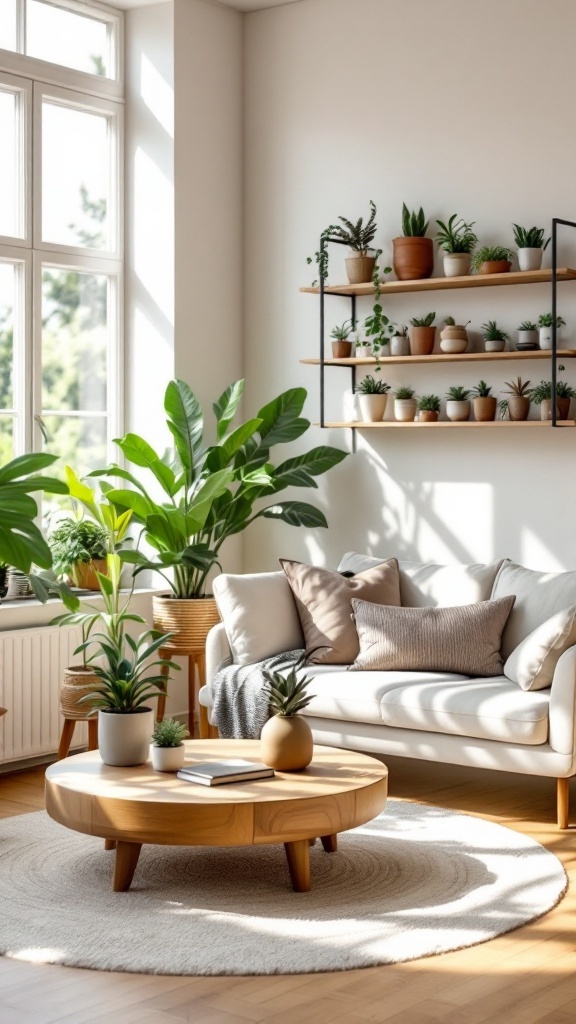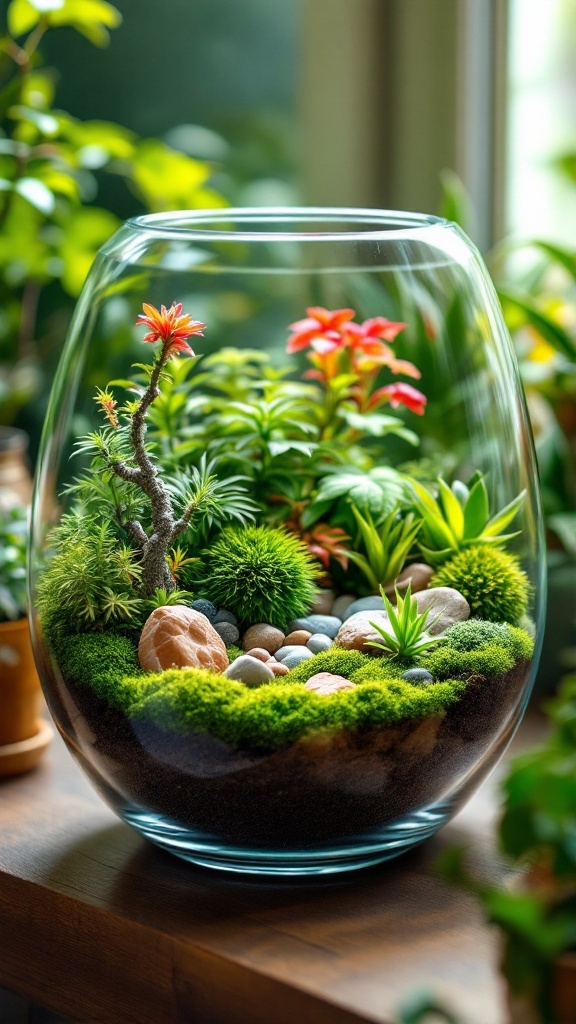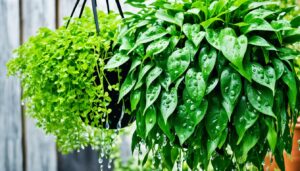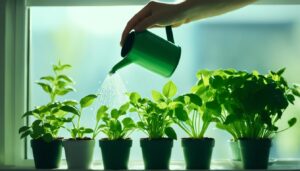With each year comes a fresh wave of exciting houseplant trends, and 2025 is no exception! From unique varieties to innovative care techniques, there’s so much to look forward to in the indoor gardening scene. Let’s jump right into the top 16 trends that are shaping the way we embrace greenery in our homes this year.
2025 Trends In Home Indoor Gardening
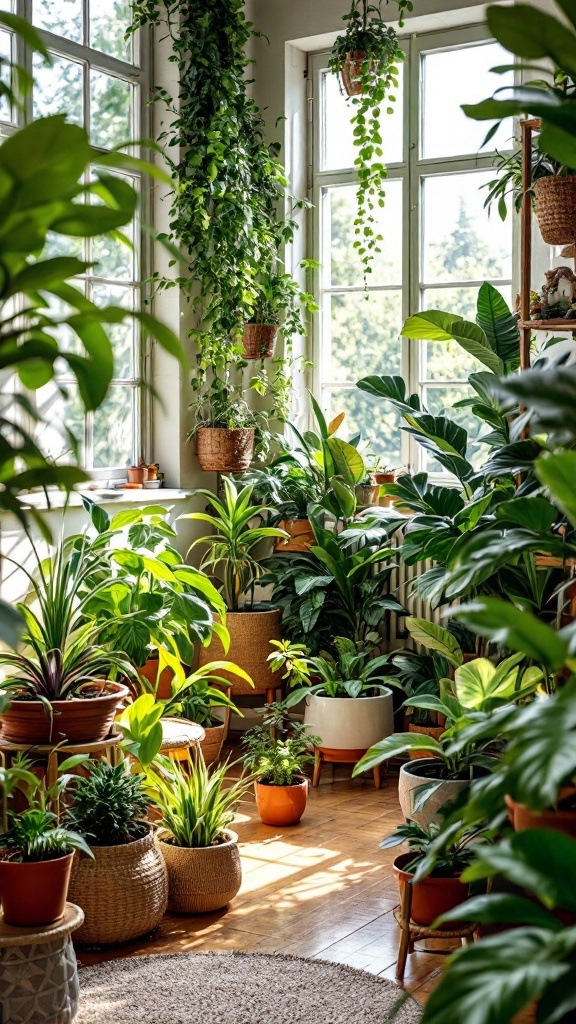
16 Must-Know Houseplant Trends for 2025 – What’s Hot This Year?
As we step into 2025, indoor gardening is evolving in exciting ways, blending style, sustainability, and smart technology. This year’s trends focus on bringing nature indoors—whether through biophilic design, space-saving plant solutions, or eco-conscious gardening practices.
From easy-care houseplants for beginners to trending houseplants for small spaces, more people are embracing low-maintenance greenery that thrives in any environment. If you’re wondering about the best low-light indoor plants for apartments or how to maximize small spaces with indoor plant furniture ideas, 2025 has plenty to offer.
For plant lovers looking to simplify care, technology is stepping in. The best smart plant monitors for beginners and self-watering pots are making it easier than ever to grow a thriving indoor jungle. Meanwhile, new houseplant varieties for 2025 are hitting the market, offering vibrant colors, unique textures, and even hybrid species designed to flourish in modern homes.
Sustainability is also a key focus, with eco-friendly houseplant care tips gaining popularity. Recycled pots, composting, and rainwater collection are becoming standard practices for mindful plant owners. And if you’re on the hunt for where to buy rare houseplants online, the collector’s market is booming with exotic and hard-to-find species.
Whether you’re a seasoned plant parent or just starting out, these 15 must-know trends will inspire you to create a lush, vibrant home filled with greenery. Get ready to explore what’s new and exciting in the world of houseplants this year!
Smart Plant Monitors
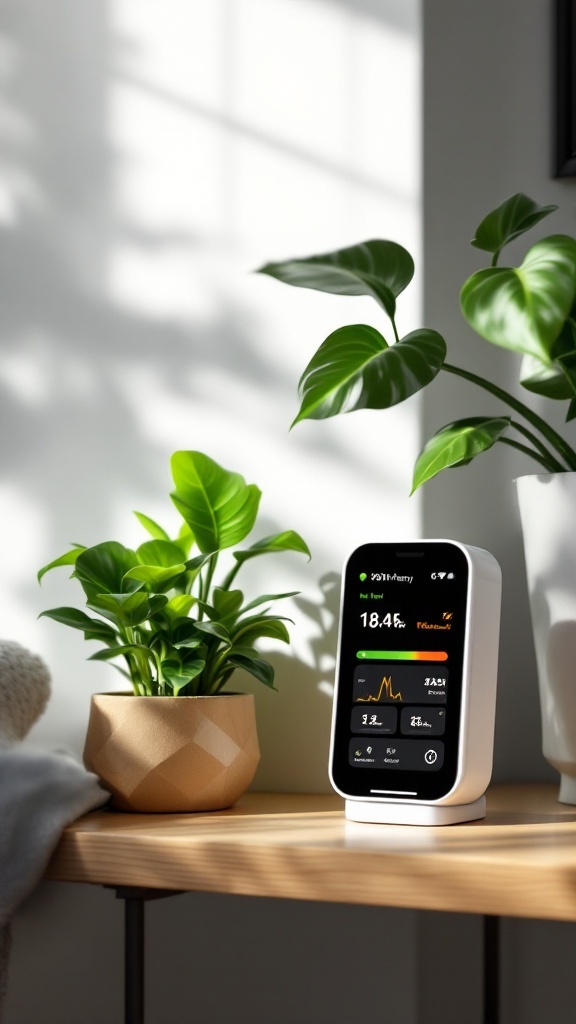
How Smart Monitors Help Houseplants Thrive
Gone are the days of guessing whether your plants need water or more sunlight. In 2025, smart plant monitors are making plant care easier, even for beginners. These high-tech devices track essential plant needs like moisture levels, light exposure, and temperature—all in real time. Some even send alerts to your phone when your plant needs attention!
Imagine never overwatering your favorite Monstera or forgetting to mist your humidity-loving Calathea. With precise data at your fingertips, smart monitors take the stress out of plant care, ensuring your leafy friends thrive with minimal effort.
For busy plant parents, these gadgets bridge the gap between technology and nature, making plant care more intuitive and enjoyable. Whether you’re nurturing easy-care houseplants or growing a collection of rare and unique plants, smart monitors offer valuable insights that help your indoor garden flourish.
Best Smart Plant Monitors to Try in 2025
With so many options available, finding the right smart plant monitor can feel overwhelming. The best ones combine ease of use, accuracy, and seamless smartphone integration.
Here are some features to look for:
✅ Real-time moisture tracking – Prevents overwatering and underwatering.
✅ Light intensity monitoring – Ensures plants get the right amount of sunlight.
✅ Temperature and humidity sensors – Ideal for tropical and delicate plants.
✅ Mobile app compatibility – Sends notifications and care recommendations.
For beginners, entry-level smart monitors provide simple, easy-to-read data, while advanced models offer AI-powered plant analysis and voice assistant integration. Whether you prefer a budget-friendly option or a high-tech system, there’s a smart monitor to fit your needs.
Incorporating technology into your plant care routine isn’t just a trend—it’s a game-changer that makes indoor gardening more accessible, efficient, and fun!
As you explore houseplant trends for 2025, integrating technology into your plant care routine is a fantastic way to enhance your indoor gardening experience. Whether you have easy-care houseplants for beginners or are diving into rare and unique houseplants to collect, smart monitors can help you succeed.
Biophilic Design & Green Living Spaces
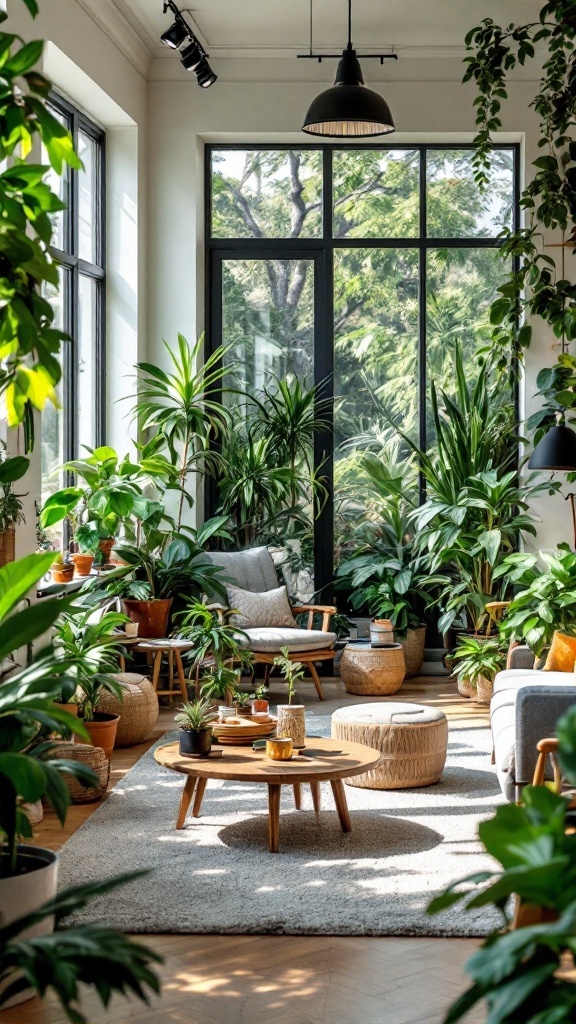
Why Biophilic Interiors Are Trending
Picture a space where lush greenery fills every corner, sunlight streams through large windows, and the air feels fresher. This is the essence of biophilic design—a trend that’s redefining indoor living in 2025. More than just decor, bringing nature indoors creates a calming, visually rich environment that enhances well-being.
As city living grows more compact, homeowners and renters alike are turning to trending houseplants for small spaces to add vibrancy without overwhelming their interiors. Popular choices like snake plants, pothos, and ZZ plants are not only low-maintenance but also thrive in low-light indoor spaces, making them perfect for apartments and offices.
How to Create a Biophilic Home with Plants
Incorporating biophilic design doesn’t require a large home or garden—just a bit of creativity. Indoor plant furniture ideas for small spaces, such as floating shelves, multi-tiered plant stands, and vertical gardens, help maximize greenery while keeping things functional. Hanging planters and wall-mounted pots bring a modern, space-saving touch, allowing even the smallest rooms to embrace nature.
To keep your indoor oasis thriving, focus on eco-friendly houseplant care tips like using recycled pots, organic fertilizers, and self-watering systems. For those who want both beauty and function, top air-purifying plants for better indoor air quality—like peace lilies and areca palms—enhance your home’s atmosphere while filtering out toxins.
If you’re looking for something truly unique, rare and unique houseplants to collect—such as variegated Monsteras or jewel orchids—can bring a one-of-a-kind touch to your space. No matter your style, embracing biophilic design in 2025 is an easy and stylish way to stay connected with nature while making your home feel alive.
Eco-Conscious Gardening Practices
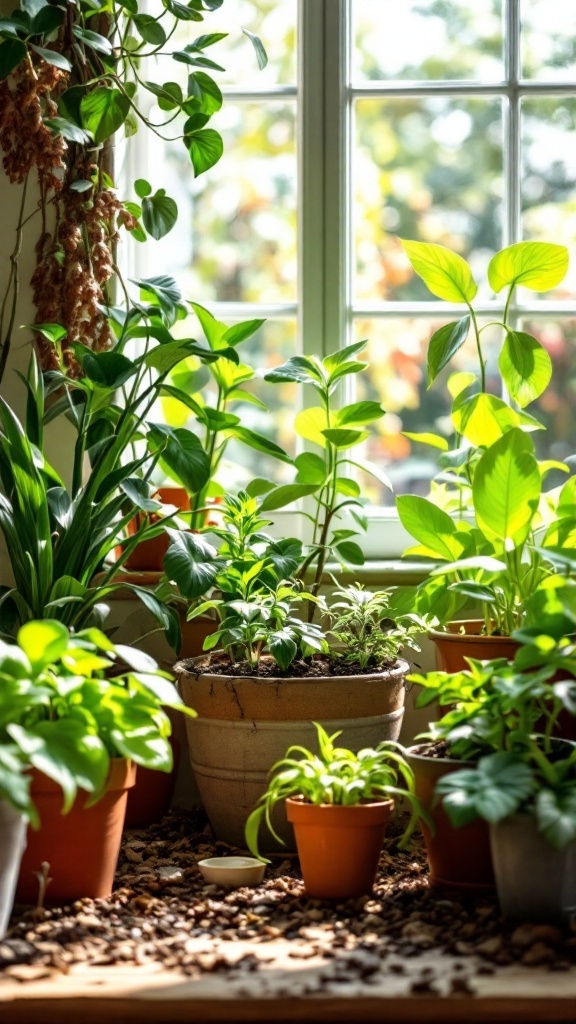
Low-Waste Houseplant Care Practices
Imagine a home filled with lush greenery, where every plant thrives with minimal waste and maximum sustainability. In 2025, eco-conscious gardening is more than just a trend—it’s a movement. Houseplant lovers are seeking ways to reduce waste, conserve resources, and make plant care more environmentally friendly.
This shift has led to a surge in easy-care houseplants for beginners, allowing more people to bring greenery into their homes without high-maintenance routines. Plus, top air-purifying plants for better indoor air quality are making waves, improving indoor spaces while supporting a healthier environment.
Eco-Friendly Products for Indoor Gardening
Sustainability starts with choosing the right tools and methods. The demand for indoor plant furniture ideas for small spaces is growing, with multi-functional plant stands, recycled-material pots, and vertical gardens helping homeowners embrace biophilic living without clutter.
For plant parents looking to simplify care while reducing water waste, the best self-watering pots for indoor plants are a game-changer. These smart solutions ensure plants receive just the right amount of water, eliminating overwatering and runoff. Meanwhile, the best smart plant monitors for beginners allow you to track soil moisture and light levels, preventing unnecessary watering and encouraging sustainable plant care habits.
As more people explore new houseplant varieties for 2025, they’re also prioritizing low-impact, eco-conscious methods. Whether it’s composting plant waste, upcycling containers into planters, or choosing organic fertilizers over chemical-based ones, small changes can make a big difference.
By adopting eco-friendly houseplant care tips, you’re not just creating a greener home—you’re contributing to a more sustainable future, one plant at a time.
Rare & Collector’S Houseplants
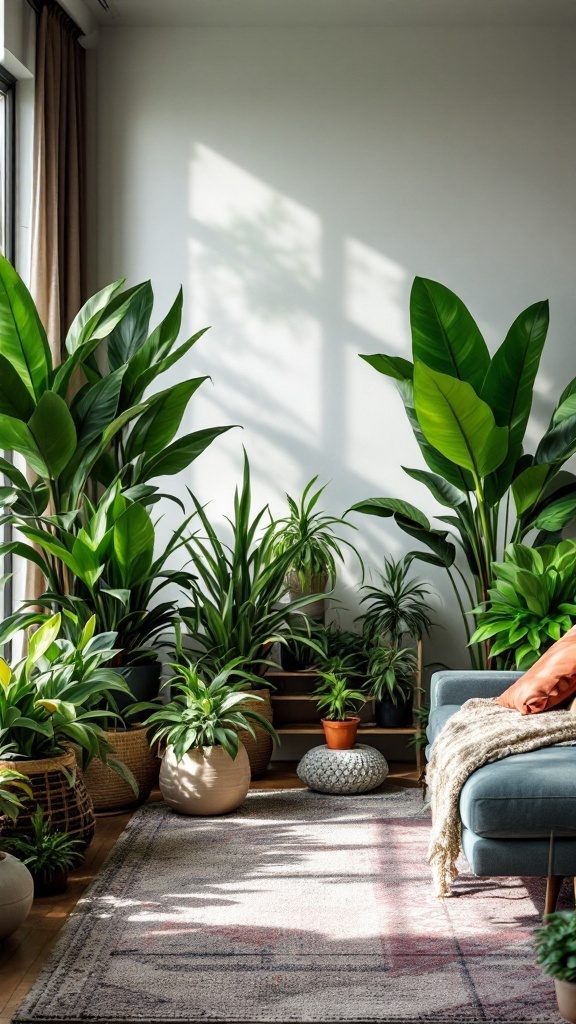
Most Sought-After Rare Houseplants of 2025
In 2025, rare and unique houseplants are more than just decorative—they’re conversation starters, collector’s items, and symbols of personal style. Plant enthusiasts are on the hunt for extraordinary foliage, rare color variations, and exotic blooms that transform living spaces into lush indoor jungles.
Picture a cozy, plant-filled room where variegated Monsteras, jewel orchids, and Philodendron Florida Beauty create a mesmerizing display. Each plant has its own story, adding texture, color, and life to the space. As interest in houseplant collecting grows, these botanical treasures are becoming the ultimate must-haves for plant lovers.
Where to Buy Rare Houseplants Online
Finding rare houseplants can be a thrilling challenge. The rise of specialty plant shops and online marketplaces has made it easier than ever to discover and purchase hard-to-find varieties. Whether you’re searching for where to buy rare houseplants online or visiting local nurseries that specialize in exotic species, 2025 offers endless opportunities to expand your collection.
As new houseplant varieties for 2025 emerge, collectors are also becoming more mindful of sustainability. Many are adopting eco-friendly houseplant care tips, such as using recycled pots, organic fertilizers, and water-efficient systems to keep their plants thriving.
Hybrid & Colorful Foliage Plants
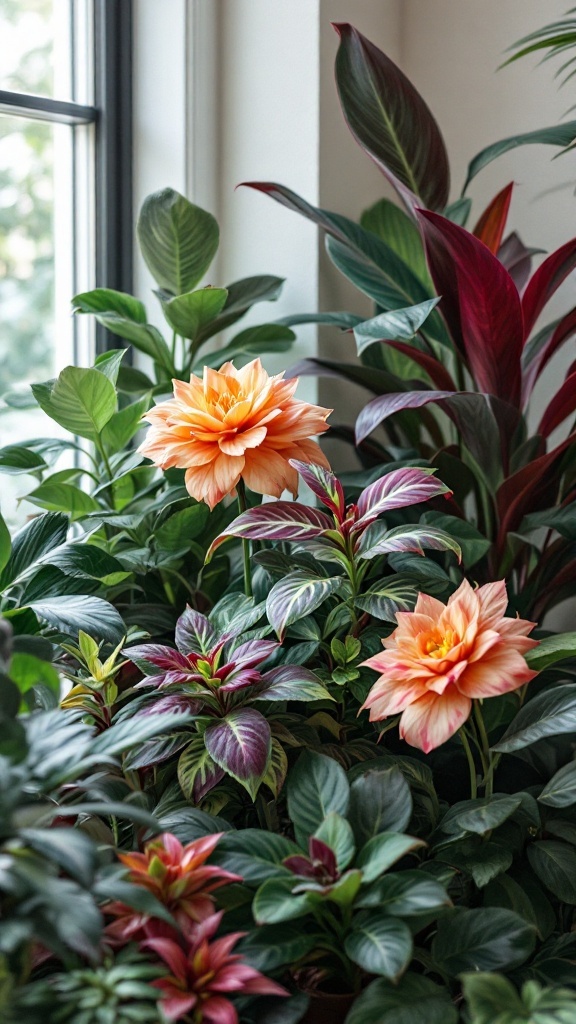
Stunning Houseplants with Unique Color Variations
In 2025, hybrid and colorful foliage plants are redefining indoor gardening, bringing bold patterns, striking hues, and one-of-a-kind textures into homes. These plants aren’t just eye-catching—they also add personality and vibrancy to any space. Whether it’s deep purple Calatheas, neon pink Aglaonemas, or fiery red Crotons, these stunning hybrids offer a fresh twist on traditional houseplants.
Picture a bright and lively indoor garden, where leaves shimmer in shades of blue, pink, and gold, creating a natural work of art. This trend toward vibrant foliage is perfect for those who want to make a statement with their plants while enjoying the benefits of greenery.
How to Care for Hybrid and Colorful Foliage Plants
Keeping these vibrant plants healthy and thriving requires proper care and the right tools. The best self-watering pots for indoor plants help maintain consistent moisture, preventing issues like overwatering and dry soil stress—both common concerns for colorful hybrids.
For those short on space, indoor plant furniture ideas for small spaces—such as hanging planters, stylish plant ladders, and floating shelves—offer creative ways to showcase colorful foliage without cluttering the home.
Additionally, as the demand for eco-friendly houseplant care tips rises, more enthusiasts are turning to organic fertilizers, sustainable potting mixes, and recycled planters to keep their collections thriving in an environmentally responsible way.
If you’re looking to elevate your indoor garden with plants that dazzle with color, hybrid and colorful foliage plants are the must-have trend for 2025. Whether you’re a collector, decorator, or beginner, these unique houseplants offer a dynamic and modern way to bring nature indoors.
Miniature & Compact Houseplants
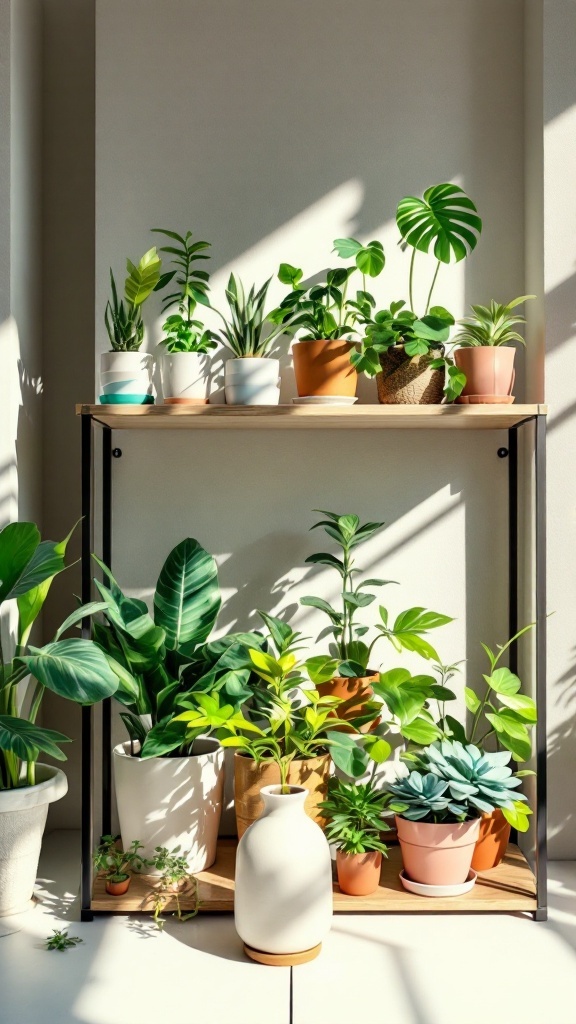
How to Style Mini Plants for Maximum Impact
In 2025, miniature and compact houseplants are becoming a must-have for plant lovers looking to bring greenery into small spaces. These tiny yet powerful plants don’t just add charm—they transform shelves, desks, and windowsills into lush, vibrant displays without taking up too much room.
Imagine a stylish corner with tiny succulents, mini ferns, and small-leaved vining plants arranged in sleek pots, creating a cozy and inviting atmosphere. Trending houseplants for small spaces, like baby rubber plants, mini orchids, and dwarf snake plants, prove that size doesn’t limit beauty.
Best Mini Houseplants for Small Spaces
For those working with limited space, the right plants can maximize greenery without cluttering your home. Top air-purifying plants for better indoor air quality, such as mini pothos and compact peace lilies, filter toxins while maintaining a low footprint.
If you’re wondering how to create a biophilic home with plants, start by incorporating mini plants into your decor. Floating shelves, hanging planters, and compact terrariums offer smart ways to show off your tiny green companions.
Caring for Compact Houseplants with Ease
Small plants require less soil and water, but that doesn’t mean they don’t need care. The best self-watering pots for indoor plants help keep moisture levels balanced, ensuring your mini greenery thrives with minimal effort. For busy plant owners, investing in the best smart plant monitors for beginners can provide real-time insights into their plant’s needs.
With new houseplant varieties for 2025 introducing even more petite, resilient options, there’s never been a better time to embrace miniature houseplants. Whether you’re a seasoned collector or just starting out with easy-care houseplants for beginners, these compact plants prove that great things come in small packages.
Low-Maintenance & Drought-Tolerant Plants
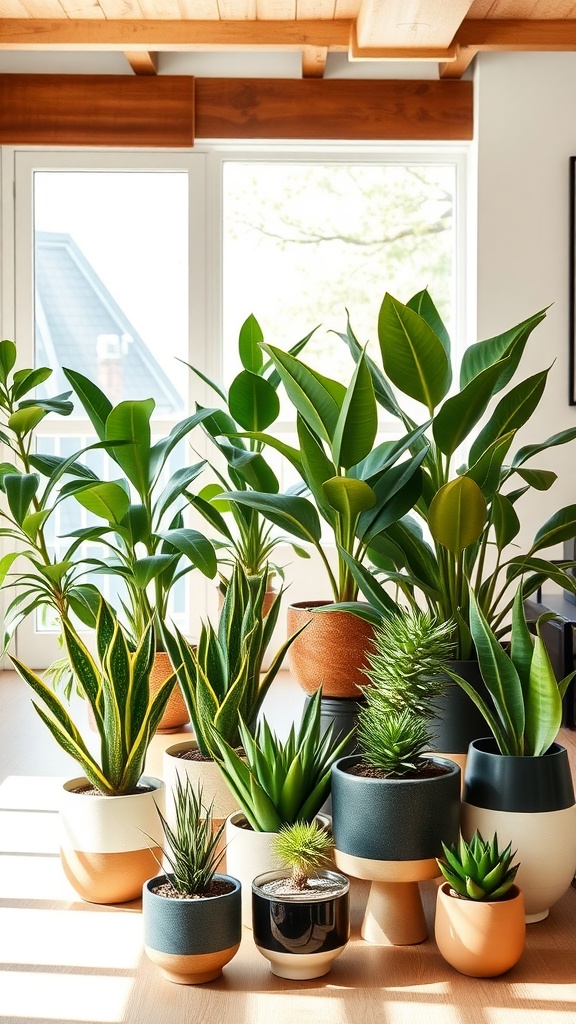
Best Plants for Forgetful Plant Owners
Not everyone has the time—or memory—to keep up with a demanding plant care routine. That’s why low-maintenance and drought-tolerant houseplants are becoming a top trend in 2025. These plants thrive with minimal attention, making them ideal for busy professionals, frequent travelers, and anyone who loves greenery without the constant upkeep.
Imagine a cozy living space where lush green plants effortlessly thrive, even if you occasionally forget to water them. Best low-light indoor plants for apartments, like snake plants and pothos, are perfect choices, as they can survive in low-light conditions and require minimal watering.
Top Drought-Tolerant Plants for Easy Care
If you tend to forget about watering, choosing drought-tolerant plants can be a game-changer. These resilient plants store moisture in their leaves or roots, allowing them to go weeks without water. Some of the best options include:
🌿 ZZ Plant – Almost indestructible, thrives in low light, and needs watering only every few weeks.
🌵 Succulents & Cacti – Adapted to dry conditions, they need watering only once the soil is completely dry.
🪴 Snake Plant – Can handle neglect, low light, and infrequent watering while purifying the air.
For those looking to improve indoor air quality, top air-purifying plants for better indoor air quality, like spider plants and peace lilies, offer both style and function. These plants remove toxins from the air while remaining incredibly easy to care for.
Making Plant Care Even Simpler
For extra convenience, the best self-watering pots for indoor plants can automate watering schedules, ensuring your plants stay hydrated even when life gets busy. And if you’re still unsure about your plant’s needs, the best smart plant monitors for beginners can track moisture, light levels, and temperature, making plant care virtually foolproof.
Whether you’re a seasoned plant collector or just starting out with easy-care houseplants for beginners, these low-maintenance options make it effortless to enjoy greenery in your home. No green thumb required!
Microgreen & Edible Indoor Gardens
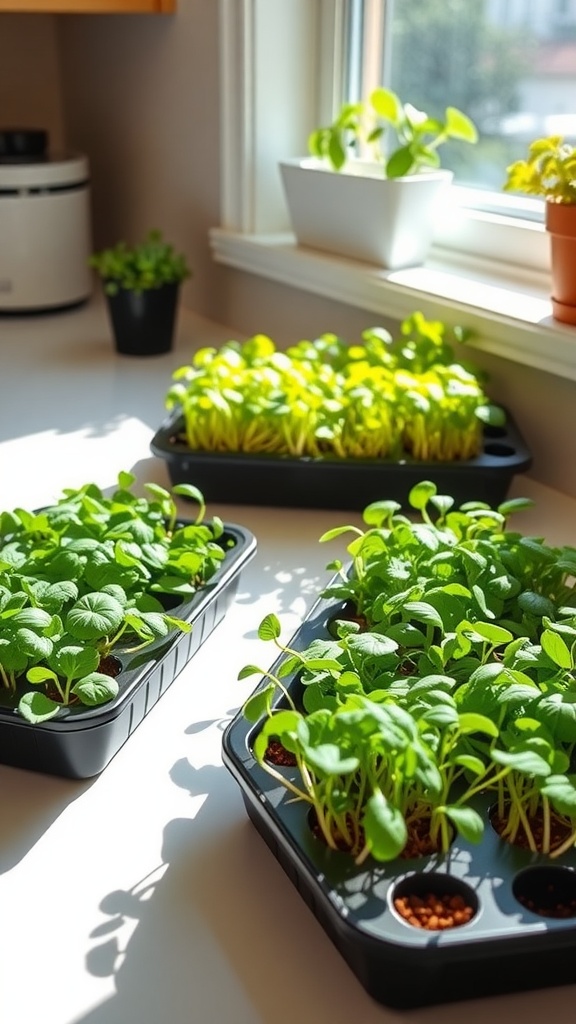
Easy Microgreens to Grow at Home
Microgreens and edible indoor gardens are gaining major popularity in 2025. These tiny, nutrient-packed greens aren’t just for chefs and foodies—they’re perfect for anyone who wants fresh, homegrown flavors in their meals without needing a large outdoor garden. Plus, they grow fast and require minimal effort, making them a top choice for urban dwellers and beginner gardeners alike.
Picture a kitchen windowsill lined with trays of vibrant microgreens, ready to be harvested in just one to two weeks. From peppery radish greens to nutrient-rich kale sprouts, growing microgreens at home is an easy way to elevate your meals while adding greenery to your space.
Best Microgreens and Indoor Edibles for Beginners
If you’re new to indoor gardening, start with microgreens that are quick-growing and easy to care for:
🥬 Sunflower Sprouts – Mild, nutty flavor and packed with vitamins.
🌱 Radish Greens – Fast-growing with a peppery kick.
🥦 Broccoli Microgreens – Full of antioxidants and grow within a week.
🌿 Basil & Cilantro Microgreens – Great for adding fresh herbs to your meals.
Microgreens are ideal for small spaces and can thrive in apartments, tiny kitchens, or even on office desks. Using self-watering pots for indoor plants ensures they stay hydrated without the hassle of daily watering.
Creating a Functional Indoor Edible Garden
Pairing microgreens with easy-care houseplants for beginners can create a visually appealing and functional indoor garden. Imagine combining trailing pothos with fresh basil or placing a mini herb garden alongside low-light plants like ZZ plants and ferns.
For those focused on sustainability, embracing eco-friendly houseplant care tips—such as recycled containers, organic soil, and water-efficient growing techniques—can make indoor gardening even more rewarding.
As houseplant trends for 2025 continue to evolve, edible indoor gardens are proving that anyone can grow their own food, no matter their space or skill level. Whether you’re a seasoned plant lover or just starting out, microgreens and edible plants bring both beauty and fresh flavors into your home.
Multi-Functional Plant Furniture
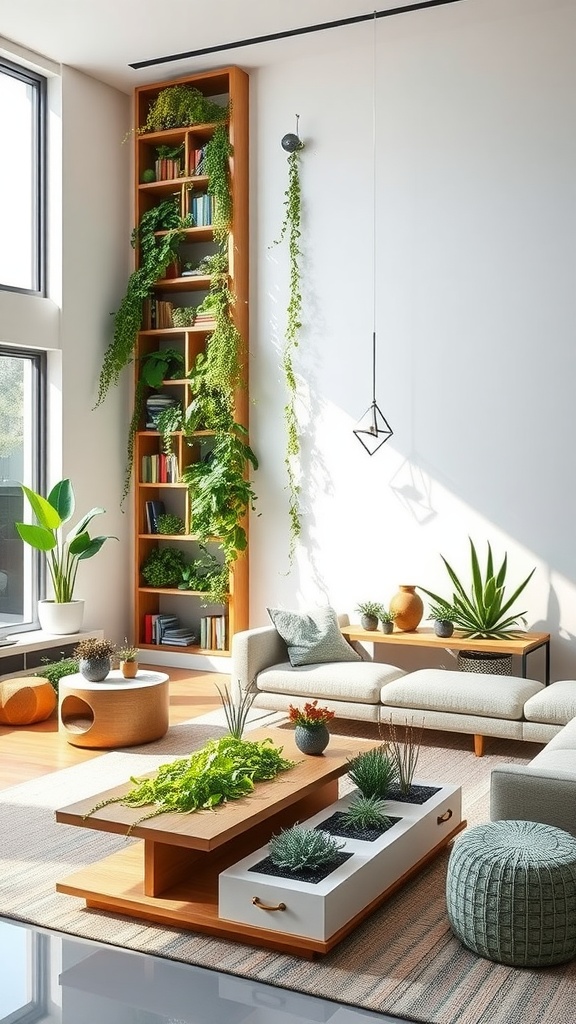
How to Integrate Greenery into Home Decor
In 2025, multi-functional plant furniture is redefining home decor, allowing houseplants to be seamlessly integrated into everyday living spaces. Imagine a cozy living room where tables double as planters, shelves hold cascading greenery, and seating areas are surrounded by lush, air-purifying plants. This trend is about blending style with practicality, creating a space where furniture and plants work together to enhance both aesthetics and function.
Picture a sleek coffee table with a built-in planter in the center of the room or a bookshelf filled with greenery instead of clutter. Trending houseplants for small spaces, like pothos and ferns, fit perfectly into compact furniture designs, allowing you to maximize your greenery without sacrificing space.
Indoor Plant Furniture Ideas for Small Spaces
For those looking to create a biophilic home with plants, the right furniture can help you display greenery in smart, space-saving ways. Some of the most popular multi-functional plant furniture ideas include:
🪴 Plant Stand Coffee Tables – Stylish tables with built-in planters that bring greenery into the heart of your home.
🌿 Vertical Plant Shelves – Maximize space with wall-mounted or tiered shelving that holds small potted plants.
💡 LED Grow Light Desks – Workspaces with integrated grow lights, perfect for low-light indoor plants.
🛋 Seating with Planters – Benches and sofas with built-in greenery, adding a refreshing, organic touch to seating areas.
These functional yet beautiful pieces help even the smallest apartments embrace nature indoors.
Pairing Plants with Smart Care Solutions
To keep your indoor jungle thriving with minimal effort, pairing the best self-watering pots for indoor plants with low-maintenance greenery is a game-changer. Top air-purifying plants for better indoor air quality, such as peace lilies and snake plants, are easy to care for and thrive in various light conditions, making them ideal for integrated furniture setups.
For those who enjoy collecting rare and unique houseplants, plant furniture offers a creative way to display them. A statement piece featuring a rare Monstera or an exotic Calathea can become the focal point of a room, sparking conversations and adding a touch of the extraordinary.
As houseplant trends for 2025 continue to evolve, multi-functional plant furniture is proving that plants and design go hand in hand. Whether you have a spacious home or a small apartment, incorporating greenery into furniture is a stylish, space-efficient, and eco-friendly way to bring nature indoors.
Air-Purifying & Wellness Plants
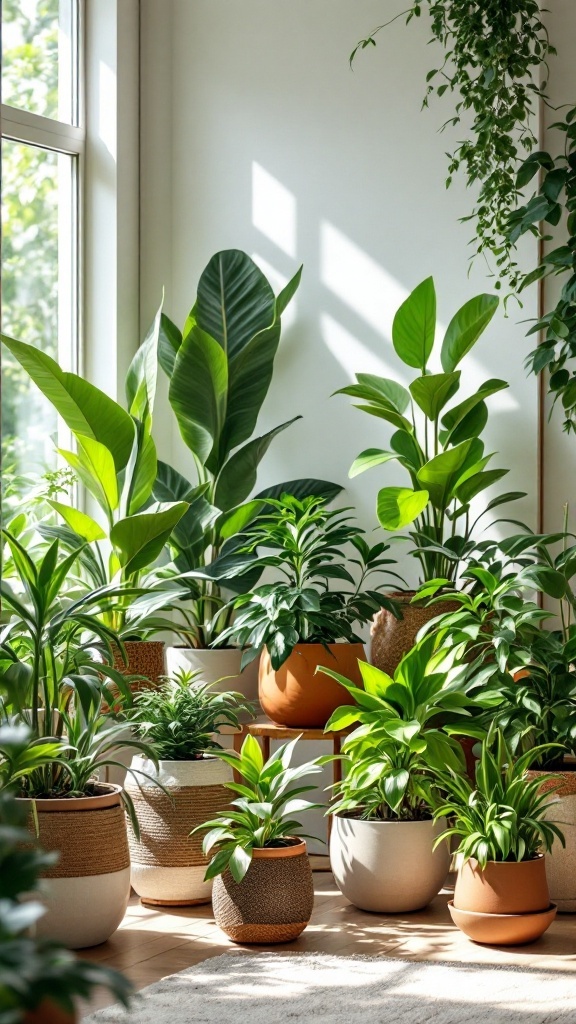
Science-Backed Benefits of Indoor Plants on Well-Being
In 2025, air-purifying plants are more than just trendy décor—they’re a science-backed way to improve indoor air quality and overall well-being. Research has shown that certain houseplants can filter toxins, reduce stress, and boost focus, making them essential for modern homes and workspaces.
Imagine a calm, green-filled space where snake plants, peace lilies, and Boston ferns not only enhance the aesthetics but also create a healthier, more breathable environment. These plants absorb harmful airborne pollutants like formaldehyde, benzene, and carbon monoxide, improving the air inside your home naturally.
Top Air-Purifying Plants for a Healthier Home
If you’re looking to breathe easier while adding greenery to your space, consider these top air-purifying plants for better indoor air quality:
🌱 Snake Plant – Filters toxins even at night, making it perfect for bedrooms.
🪴 Peace Lily – Removes airborne mold spores and adds a touch of elegance.
🌿 Areca Palm – Acts as a natural humidifier, great for dry indoor spaces.
🍃 Boston Fern – Absorbs formaldehyde and improves air moisture.
For urban dwellers and small-space enthusiasts, trending houseplants for small spaces like pothos and rubber plants offer air-purifying benefits without taking up much room.
How to Keep Air-Purifying Plants Thriving
To maximize the benefits of these plants, consider strategic placement in areas where they can absorb pollutants—such as near windows, workspaces, and sleeping areas. Creating a biophilic home with plants means thoughtfully incorporating greenery into your environment for both visual appeal and functional benefits.
For easy maintenance, the best self-watering pots for indoor plants ensure that your plants get the right amount of moisture without daily upkeep. Pairing them with the best smart plant monitors for beginners can also help track light exposure, humidity, and watering needs, making plant care effortless and stress-free.
The Future of Wellness with Air-Purifying Plants
As more people embrace eco-friendly houseplant care tips, air-purifying plants are becoming a natural solution for cleaner indoor air. Whether you’re a beginner looking for easy-care houseplants or a collector of rare and unique houseplants, these green companions can enhance both your living space and your health.
By choosing air-purifying plants, you’re not just decorating—you’re investing in a healthier, fresher home.
Virtual Plant Communities & Online Plant Swaps
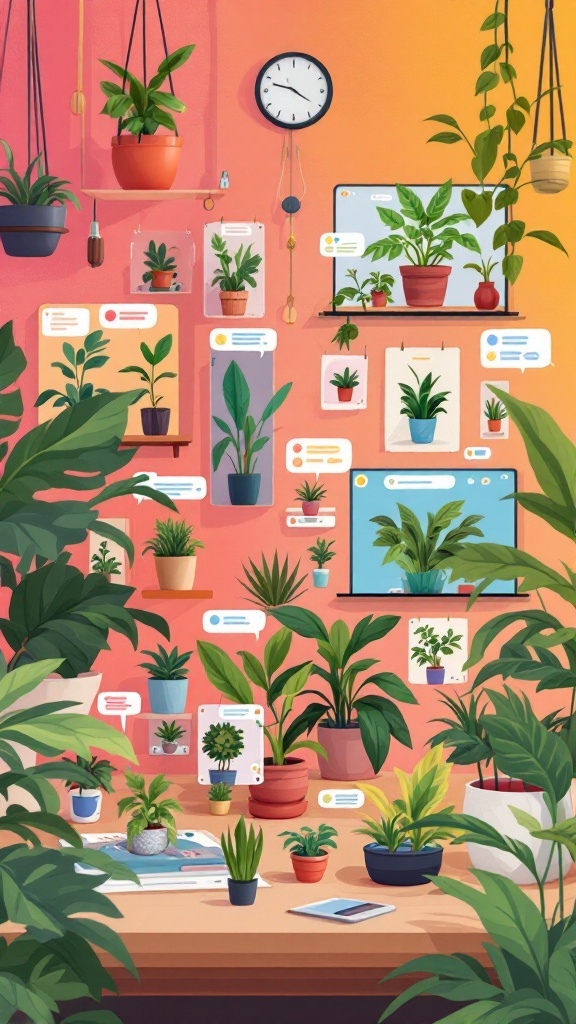
How to Trade and Sell Houseplants in Digital Spaces
In 2025, virtual plant communities are flourishing, bringing plant lovers together to share, trade, and sell houseplants online like never before. Whether you’re on the hunt for rare and unique houseplants to collect or just looking for easy-care houseplants for beginners, online forums and social media groups are making plant trading more accessible and exciting.
Imagine connecting with fellow plant enthusiasts, swapping propagation cuttings, and discussing where to buy rare houseplants online—all from the comfort of your home. These digital spaces create a sense of community, allowing plant parents to learn from one another, showcase their collections, and exchange expert tips on plant care.
The Rise of Virtual Plant Swaps
One of the biggest trends in online plant communities is the rise of virtual plant swaps. These allow plant lovers to exchange cuttings, seedlings, or even fully grown plants without having to purchase them from traditional stores.
🌱 Sustainability Benefits – Trading plants helps reduce waste and overproduction while promoting a circular economy within the plant world.
🪴 Discover New Houseplant Varieties for 2025 – Virtual swaps make it easy to find rare species that might not be available at local garden centers.
📦 Shipping Made Simple – Many platforms now offer guides on safely packaging plants, ensuring they arrive healthy and ready to thrive.
From top air-purifying plants for better indoor air quality to the best low-light indoor plants for apartments, virtual swaps make expanding your collection easy and cost-effective.
Finding the Right Plant Community for You
Whether you’re a beginner looking for eco-friendly houseplant care tips or an experienced collector interested in the best self-watering pots for indoor plants, there’s an online plant community waiting for you. Popular places to engage include:
🌿 Facebook Groups – Thousands of plant-specific groups for swapping, selling, and learning.
🌱 Reddit Communities (r/houseplants, r/planttrades, r/plantclinic) – A great place for expert advice and plant trading.
📸 Instagram & TikTok – Perfect for discovering plant trends, care hacks, and trade opportunities.
🛍️ Plant Marketplaces (Etsy, eBay, Local Trading Apps) – For those looking to buy and sell plants directly.
These platforms help break geographical barriers, allowing plant lovers to connect with like-minded individuals around the world. Whether you’re interested in houseplant trends for 2025, indoor plant furniture ideas for small spaces, or just making new plant-loving friends, digital plant communities are the place to be.
By joining these virtual spaces, you’re not just expanding your plant collection—you’re becoming part of a thriving, green-loving movement!
Terrariums & Self-Sustaining Ecosystems
Why Terrariums Are Making a Comeback
In 2025, terrariums and enclosed ecosystem cabinets are redefining indoor gardening, offering a low-maintenance yet visually stunning way to bring nature indoors. These self-sustaining mini ecosystems not only add charm to any space but also create an effortless green oasis with minimal upkeep.
Imagine a beautifully arranged glass terrarium, filled with lush moss, ferns, and pebbles, forming a tiny jungle that thrives on its own. The enclosed environment helps regulate moisture, temperature, and humidity, making it an ideal home for easy-care houseplants for beginners. Succulents, air plants, and miniature orchids are some of the best plants for terrariums, as they flourish in these compact, self-contained worlds.
Creating a Self-Sustaining Ecosystem at Home
One of the biggest reasons terrariums and ecosystem cabinets are trending is their ability to function as self-sustaining plant environments. Whether you’re creating a closed terrarium that waters itself or investing in a high-tech ecosystem cabinet with built-in humidity and light controls, these systems allow you to grow a thriving indoor jungle with little maintenance.
🌿 Best Plants for Terrariums – Mini ferns, fittonias, mosses, and baby tears flourish in enclosed setups.
🛠 Ecosystem Cabinets – These controlled glass environments are perfect for rare and unique houseplants to collect, providing optimal humidity and lighting conditions.
💧 Self-Watering Systems – Many terrariums naturally recycle water, but using the best self-watering pots for indoor plants can enhance moisture control for semi-enclosed setups.
If you’re interested in indoor plant furniture ideas for small spaces, terrariums fit seamlessly into shelves, coffee tables, and even wall-mounted frames, making them an ideal choice for apartment dwellers.
Why Terrariums Are a Must-Have in 2025
Terrariums aren’t just beautiful—they’re practical, eco-friendly, and perfect for busy plant lovers. These tiny ecosystems help improve indoor air quality, support biophilic home design, and provide a stress-free way to enjoy greenery without constant watering or care.
For those looking to create a biophilic home with plants, terrariums offer a stylish and functional solution. Whether you opt for a small glass dome on your desk or a full-scale ecosystem cabinet, these compact green spaces allow you to connect with nature in a modern and effortless way. If you want to see more about designing and creating your own terrarium check out our post here. This is a fun and beautiful addition to any home that is so easy to care for its a must plant lover addition.
Natural & Botanical Home Fragrances
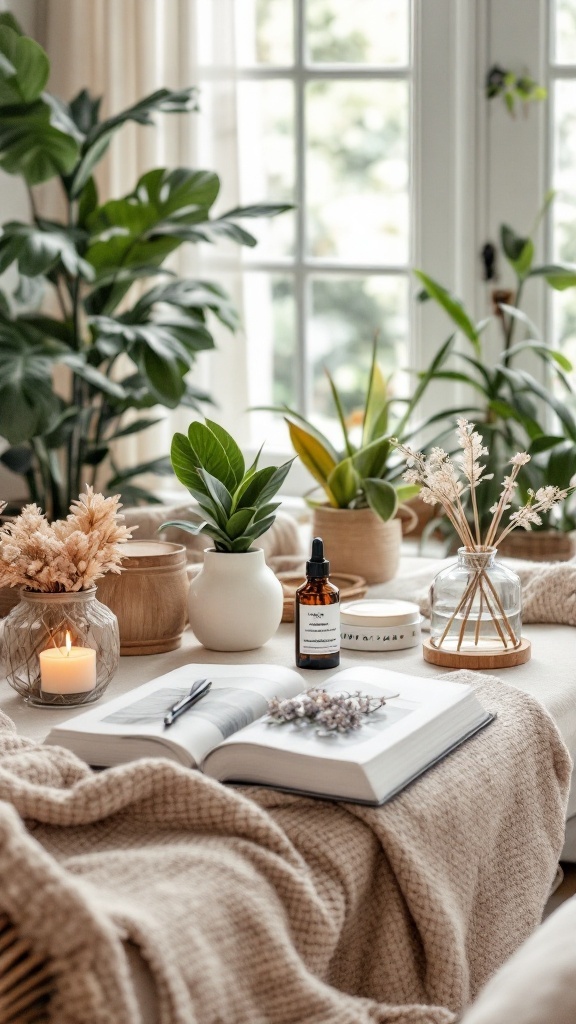
Plants That Naturally Scent Your Home
In 2025, natural and botanical home fragrances are becoming a must-have for plant lovers looking to create a fresh, serene atmosphere indoors. As more people embrace biophilic design, the focus is shifting toward houseplants that not only beautify spaces but also fill them with delightful, natural scents.
Imagine stepping into a bright, plant-filled room, where the sweet aroma of jasmine, the calming scent of eucalyptus, and the refreshing notes of lavender transform your home into a tranquil retreat. Unlike artificial air fresheners, these fragrant plants provide a continuous, chemical-free way to enhance your living space.
Best Scented Houseplants for a Naturally Fragrant Home
If you love the idea of bringing nature’s scents indoors, consider adding these aromatic plants to your collection:
🌿 Jasmine – Fills the air with a sweet, floral aroma, perfect for bedrooms or relaxation spaces.
🌱 Eucalyptus – Releases a refreshing, spa-like scent that promotes clear breathing and relaxation.
🍋 Lemon Balm & Citrus Trees – Offer zesty, uplifting fragrances that freshen up kitchens and living areas.
🌸 Lavender – Known for its calming, stress-relieving properties, making it ideal for meditation corners.
Pairing these with top air-purifying plants for better indoor air quality ensures that your home not only smells amazing but also has cleaner, fresher air.
Enhancing Your Space with Botanical Fragrances
Beyond plants, many homeowners are incorporating eco-friendly home fragrance products to complement their greenery. Consider:
🕯 Soy Wax Candles – Infused with natural essential oils to add soft, botanical scents.
💨 Essential Oil Diffusers – Blend seamlessly with plant displays to enhance the natural biophilic aesthetic.
🌾 Dried Herb Bundles – Hanging eucalyptus in the shower or lavender near the bed brings long-lasting fragrance.
For those working with indoor plant furniture ideas for small spaces, combining fragrant houseplants with minimalist decor creates a stylish, nature-inspired environment. Trending houseplants for small spaces, like pothos and ferns, pair beautifully with aromatic plants, giving both visual and sensory appeal to any room.
Bringing Nature’s Fragrance Indoors
By incorporating fragrant houseplants and botanical home scents, you can create a peaceful, spa-like sanctuary right at home. Whether through live plants, natural candles, or essential oils, this trend blends the power of nature with home decor in a way that feels both refreshing and timeless.
In 2025, filling your home with natural scents isn’t just about aesthetics—it’s about well-being, relaxation, and connecting with nature in a more personal way.
Climbing & Trailing Plants for Vertical Decor
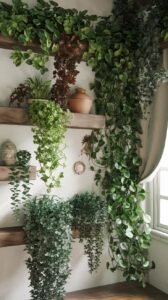
In 2025, climbing and trailing plants are becoming an essential part of modern home decor, offering a way to maximize greenery without taking up floor space. Whether cascading from shelves, climbing trellises, or forming lush green walls, these plants add depth, movement, and natural beauty to any room.
Imagine a bright living space where pothos vines drape elegantly from floating shelves, a monstera climbs a trellis, and string of pearls spills gracefully over a hanging planter. These versatile and stylish plants are perfect for small apartments, workspaces, and urban homes where space is limited but the love for greenery is limitless.
Best Vining Plants for Stylish Indoor Gardens
For those looking to create a lush, vertical display, here are some of the best climbing and trailing houseplants:
🌿 Pothos (Devil’s Ivy) – Easy to grow, thrives in low-light indoor spaces, and purifies the air.
🍃 Philodendron Brasil – Features vibrant green and yellow variegation, adding a splash of color to shelves.
🪴 String of Hearts – A delicate, trailing plant that thrives in hanging planters.
🌱 Monstera Adansonii (Swiss Cheese Vine) – Creates a bold statement with its fenestrated leaves.
Whether you have a spacious home or a compact apartment, these trailing plants bring life and movement to any environment.
How to Set Up a Stunning Green Wall
One of the most exciting ways to incorporate trailing plants into your home is by creating a vertical garden or living wall. Here’s how to make the most of the climbing plant trend:
🪴 Wall-Mounted Planters – Save space by installing modern wall-mounted plant holders.
🌿 Trellises & Ladders – Give vining plants support to climb, turning them into a focal point.
🛋 Indoor Plant Furniture Ideas for Small Spaces – Attach planters to bookshelves, room dividers, or hanging rails for aesthetic and functional greenery.
💡 Grow Lights for Vertical Setups – If your climbing plants are in low-light spaces, consider the best smart plant monitors for beginners to track light levels.
By incorporating trailing houseplants, you can bring nature’s beauty indoors in a fresh and modern way. Whether draped over furniture, climbing trellises, or forming a lush green curtain, climbing and trailing plants are redefining indoor gardening in 2025.
High-Tech Indoor Greenhouses & Grow Lights
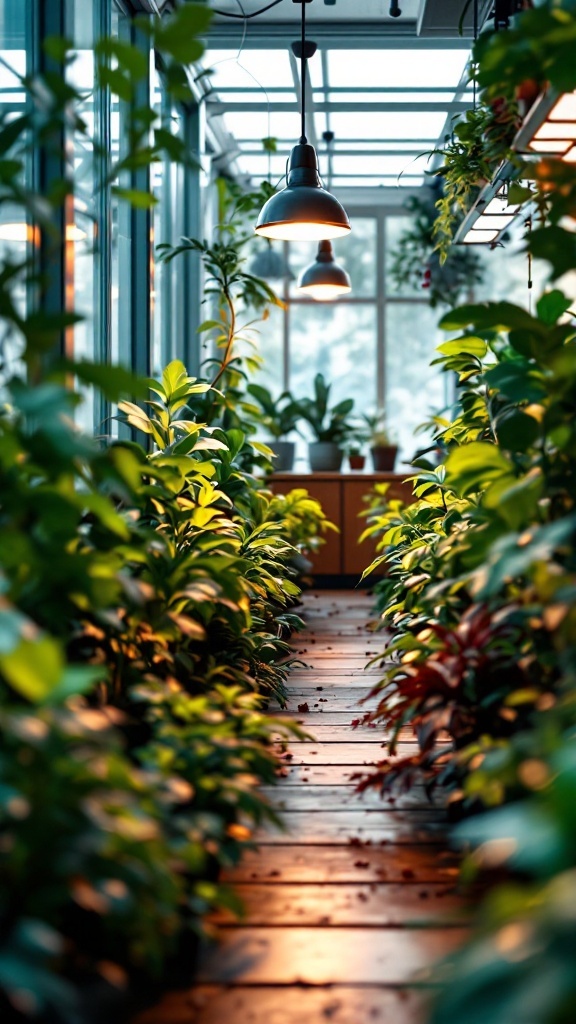
Smart Technology is Changing Indoor Gardening
As we enter 2025, high-tech indoor greenhouses and advanced grow lights are revolutionizing how we care for houseplants. These innovative setups provide perfectly controlled environments, ensuring that even the most delicate plants can thrive indoors. With smart sensors, automated watering systems, and energy-efficient LED grow lights, plant lovers can now nurture their favorite greenery effortlessly.
Picture a modern indoor greenhouse, softly illuminated by smart grow lights, filled with rare tropical plants, trailing vines, and compact edible gardens. Whether you’re working with trending houseplants for small spaces or expanding your collection with new houseplant varieties in 2025, these setups make indoor gardening more accessible and successful than ever.
Best Smart Indoor Greenhouses & Grow Lights
For those looking to enhance plant care with technology, investing in smart indoor greenhouses and grow lights is a game-changer. Here’s what to look for:
💡 Full-Spectrum LED Grow Lights – Mimic natural sunlight, helping low-light indoor plants for apartments flourish.
🌡 Humidity & Temperature Control – Maintain ideal conditions for rare and unique houseplants to collect.
💧 Self-Watering & Smart Monitoring – The best smart plant monitors for beginners track moisture levels and light intensity to prevent over- or underwatering.
🏡 Compact Indoor Greenhouses – Great for small-space gardeners, allowing you to grow tropical plants, herbs, or microgreens year-round.
From pothos and snake plants to exotic orchids, controlled indoor greenhouses offer the perfect solution for those who want healthy, thriving plants without constant upkeep.
Integrating Smart Gardening into Home Decor
Beyond their functionality, indoor greenhouses and grow lights are also being incorporated into modern home decor. Here’s how to blend plant tech with style:
🪴 Indoor Plant Furniture Ideas for Small Spaces – Compact plant cabinets with built-in lighting make beautiful statement pieces.
💡 Wall-Mounted Grow Light Systems – Sleek, minimal designs allow plants to thrive in dimly lit rooms while doubling as art.
🌱 Self-Sustaining Eco-Gardens – Combining the best self-watering pots for indoor plants with automated light and humidity controls takes low-maintenance gardening to the next level.

Why Smart Indoor Gardening is the Future
With eco-friendly houseplant care tips and smart automation, taking care of houseplants in 2025 is easier, more sustainable, and more efficient than ever. Whether you’re growing air-purifying plants to improve indoor air quality or setting up an herb garden in your kitchen, integrating technology into your indoor garden allows you to create a thriving, biophilic home with plants.
This isn’t just a trend—it’s the future of indoor gardening. With the right tech, anyone can become a successful plant parent, no matter their space or experience level.
Sustainable & Recycled Planting Solutions: The Future of Eco-Friendly Gardening
In 2025, sustainability in houseplant care is becoming more than just a trend—it’s a movement. As more people seek eco-friendly houseplant care tips, there’s a growing interest in recycled and upcycled planting solutions that minimize waste while maximizing plant health.
Imagine a plant lover’s home filled with repurposed containers, from vintage teacups turned into succulent pots to wooden crates transformed into stylish plant stands. This creative and sustainable approach to indoor gardening is not only great for the environment but also adds character and uniqueness to plant displays.
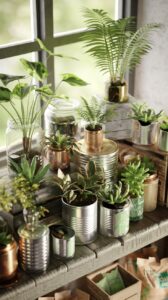
Eco-Friendly Houseplant Care Ideas
For those looking to reduce waste while still enjoying a lush indoor jungle, here are some sustainable planting solutions:
♻️ Recycled & Upcycled Planters – Old jars, baskets, and tin cans can be repurposed into stylish plant pots.
🌱 Compost-Based Soil & Organic Fertilizers – Creating nutrient-rich soil from food scraps supports healthy plant growth naturally.
💧 Self-Watering Systems Using Recycled Materials – DIY self-watering planters made from plastic bottles or ceramic wicking systems help conserve water and reduce plant care efforts.
🌿 Hydroponic & Soil-Free Gardening – Using water-based systems to grow houseplants without soil minimizes waste and creates a low-maintenance indoor ecosystem.
Why Sustainable Plant Care Matters
As houseplant trends for 2025 continue to evolve, the shift toward eco-friendly houseplant care tips is reshaping how people interact with their plants. Using recycled materials and sustainable practices isn’t just about reducing waste—it’s about creating a more mindful, conscious way to grow and nurture plants.
Whether you’re using the best self-watering pots for indoor plants, trying indoor plant furniture ideas for small spaces, or setting up a biophilic home with plants, integrating sustainable practices into your plant care routine makes a positive impact on both your indoor environment and the planet.
Eco-conscious gardening is the future. Why not start now?
Bringing the Future of Houseplants into Your Home
As houseplant trends for 2025 continue to evolve, one thing is clear—indoor gardening is becoming smarter, more sustainable, and more creative than ever. Whether you’re exploring biophilic design, smart plant technology, air-purifying greenery, or rare and unique houseplants, there’s never been a better time to elevate your indoor garden.
From eco-conscious plant care to vibrant foliage and multi-functional plant furniture, these trends offer something for every plant lover, no matter your space or experience level. By embracing these innovations, you can create a thriving, stylish, and sustainable indoor oasis that enhances both your well-being and your home’s aesthetic.
Want to stay ahead of the latest houseplant trends and get expert plant care tips delivered right to your inbox? 🌿✨
🌱 Subscribe to our newsletter to get exclusive insights on plant care, new houseplant varieties, and eco-friendly gardening solutions!
🎥 For more inspiration and hands-on plant care tips, be sure to follow Michelle at Gardening TLC on YouTube @GardeningTLC. She’s your go-to source for everything plants, from beginner guides to expert-level care strategies!
Join us in growing something amazing in 2025! 🌿💚
With each year comes a fresh wave of exciting houseplant trends, and 2025 is no exception! From unique varieties to innovative care techniques, there’s so much to look forward to in the indoor gardening scene. Let’s jump right into the top 16 trends that are shaping the way we embrace greenery in our homes this year.
2025 Trends In Home Indoor Gardening

16 Must-Know Houseplant Trends for 2025 – What’s Hot This Year?
As we step into 2025, indoor gardening is evolving in exciting ways, blending style, sustainability, and smart technology. This year’s trends focus on bringing nature indoors—whether through biophilic design, space-saving plant solutions, or eco-conscious gardening practices.
From easy-care houseplants for beginners to trending houseplants for small spaces, more people are embracing low-maintenance greenery that thrives in any environment. If you’re wondering about the best low-light indoor plants for apartments or how to maximize small spaces with indoor plant furniture ideas, 2025 has plenty to offer.
For plant lovers looking to simplify care, technology is stepping in. The best smart plant monitors for beginners and self-watering pots are making it easier than ever to grow a thriving indoor jungle. Meanwhile, new houseplant varieties for 2025 are hitting the market, offering vibrant colors, unique textures, and even hybrid species designed to flourish in modern homes.
Sustainability is also a key focus, with eco-friendly houseplant care tips gaining popularity. Recycled pots, composting, and rainwater collection are becoming standard practices for mindful plant owners. And if you’re on the hunt for where to buy rare houseplants online, the collector’s market is booming with exotic and hard-to-find species.
Whether you’re a seasoned plant parent or just starting out, these 15 must-know trends will inspire you to create a lush, vibrant home filled with greenery. Get ready to explore what’s new and exciting in the world of houseplants this year!
Smart Plant Monitors

How Smart Monitors Help Houseplants Thrive
Gone are the days of guessing whether your plants need water or more sunlight. In 2025, smart plant monitors are making plant care easier, even for beginners. These high-tech devices track essential plant needs like moisture levels, light exposure, and temperature—all in real time. Some even send alerts to your phone when your plant needs attention!
Imagine never overwatering your favorite Monstera or forgetting to mist your humidity-loving Calathea. With precise data at your fingertips, smart monitors take the stress out of plant care, ensuring your leafy friends thrive with minimal effort.
For busy plant parents, these gadgets bridge the gap between technology and nature, making plant care more intuitive and enjoyable. Whether you’re nurturing easy-care houseplants or growing a collection of rare and unique plants, smart monitors offer valuable insights that help your indoor garden flourish.
Best Smart Plant Monitors to Try in 2025
With so many options available, finding the right smart plant monitor can feel overwhelming. The best ones combine ease of use, accuracy, and seamless smartphone integration.
Here are some features to look for:
✅ Real-time moisture tracking – Prevents overwatering and underwatering.
✅ Light intensity monitoring – Ensures plants get the right amount of sunlight.
✅ Temperature and humidity sensors – Ideal for tropical and delicate plants.
✅ Mobile app compatibility – Sends notifications and care recommendations.
For beginners, entry-level smart monitors provide simple, easy-to-read data, while advanced models offer AI-powered plant analysis and voice assistant integration. Whether you prefer a budget-friendly option or a high-tech system, there’s a smart monitor to fit your needs.
Incorporating technology into your plant care routine isn’t just a trend—it’s a game-changer that makes indoor gardening more accessible, efficient, and fun!
As you explore houseplant trends for 2025, integrating technology into your plant care routine is a fantastic way to enhance your indoor gardening experience. Whether you have easy-care houseplants for beginners or are diving into rare and unique houseplants to collect, smart monitors can help you succeed.
Biophilic Design & Green Living Spaces

Why Biophilic Interiors Are Trending
Picture a space where lush greenery fills every corner, sunlight streams through large windows, and the air feels fresher. This is the essence of biophilic design—a trend that’s redefining indoor living in 2025. More than just decor, bringing nature indoors creates a calming, visually rich environment that enhances well-being.
As city living grows more compact, homeowners and renters alike are turning to trending houseplants for small spaces to add vibrancy without overwhelming their interiors. Popular choices like snake plants, pothos, and ZZ plants are not only low-maintenance but also thrive in low-light indoor spaces, making them perfect for apartments and offices.
How to Create a Biophilic Home with Plants
Incorporating biophilic design doesn’t require a large home or garden—just a bit of creativity. Indoor plant furniture ideas for small spaces, such as floating shelves, multi-tiered plant stands, and vertical gardens, help maximize greenery while keeping things functional. Hanging planters and wall-mounted pots bring a modern, space-saving touch, allowing even the smallest rooms to embrace nature.
To keep your indoor oasis thriving, focus on eco-friendly houseplant care tips like using recycled pots, organic fertilizers, and self-watering systems. For those who want both beauty and function, top air-purifying plants for better indoor air quality—like peace lilies and areca palms—enhance your home’s atmosphere while filtering out toxins.
If you’re looking for something truly unique, rare and unique houseplants to collect—such as variegated Monsteras or jewel orchids—can bring a one-of-a-kind touch to your space. No matter your style, embracing biophilic design in 2025 is an easy and stylish way to stay connected with nature while making your home feel alive.
Eco-Conscious Gardening Practices

Low-Waste Houseplant Care Practices
Imagine a home filled with lush greenery, where every plant thrives with minimal waste and maximum sustainability. In 2025, eco-conscious gardening is more than just a trend—it’s a movement. Houseplant lovers are seeking ways to reduce waste, conserve resources, and make plant care more environmentally friendly.
This shift has led to a surge in easy-care houseplants for beginners, allowing more people to bring greenery into their homes without high-maintenance routines. Plus, top air-purifying plants for better indoor air quality are making waves, improving indoor spaces while supporting a healthier environment.
Eco-Friendly Products for Indoor Gardening
Sustainability starts with choosing the right tools and methods. The demand for indoor plant furniture ideas for small spaces is growing, with multi-functional plant stands, recycled-material pots, and vertical gardens helping homeowners embrace biophilic living without clutter.
For plant parents looking to simplify care while reducing water waste, the best self-watering pots for indoor plants are a game-changer. These smart solutions ensure plants receive just the right amount of water, eliminating overwatering and runoff. Meanwhile, the best smart plant monitors for beginners allow you to track soil moisture and light levels, preventing unnecessary watering and encouraging sustainable plant care habits.
As more people explore new houseplant varieties for 2025, they’re also prioritizing low-impact, eco-conscious methods. Whether it’s composting plant waste, upcycling containers into planters, or choosing organic fertilizers over chemical-based ones, small changes can make a big difference.
By adopting eco-friendly houseplant care tips, you’re not just creating a greener home—you’re contributing to a more sustainable future, one plant at a time.
Rare & Collector’S Houseplants

Most Sought-After Rare Houseplants of 2025
In 2025, rare and unique houseplants are more than just decorative—they’re conversation starters, collector’s items, and symbols of personal style. Plant enthusiasts are on the hunt for extraordinary foliage, rare color variations, and exotic blooms that transform living spaces into lush indoor jungles.
Picture a cozy, plant-filled room where variegated Monsteras, jewel orchids, and Philodendron Florida Beauty create a mesmerizing display. Each plant has its own story, adding texture, color, and life to the space. As interest in houseplant collecting grows, these botanical treasures are becoming the ultimate must-haves for plant lovers.
Where to Buy Rare Houseplants Online
Finding rare houseplants can be a thrilling challenge. The rise of specialty plant shops and online marketplaces has made it easier than ever to discover and purchase hard-to-find varieties. Whether you’re searching for where to buy rare houseplants online or visiting local nurseries that specialize in exotic species, 2025 offers endless opportunities to expand your collection.
As new houseplant varieties for 2025 emerge, collectors are also becoming more mindful of sustainability. Many are adopting eco-friendly houseplant care tips, such as using recycled pots, organic fertilizers, and water-efficient systems to keep their plants thriving.
Hybrid & Colorful Foliage Plants

Stunning Houseplants with Unique Color Variations
In 2025, hybrid and colorful foliage plants are redefining indoor gardening, bringing bold patterns, striking hues, and one-of-a-kind textures into homes. These plants aren’t just eye-catching—they also add personality and vibrancy to any space. Whether it’s deep purple Calatheas, neon pink Aglaonemas, or fiery red Crotons, these stunning hybrids offer a fresh twist on traditional houseplants.
Picture a bright and lively indoor garden, where leaves shimmer in shades of blue, pink, and gold, creating a natural work of art. This trend toward vibrant foliage is perfect for those who want to make a statement with their plants while enjoying the benefits of greenery.
How to Care for Hybrid and Colorful Foliage Plants
Keeping these vibrant plants healthy and thriving requires proper care and the right tools. The best self-watering pots for indoor plants help maintain consistent moisture, preventing issues like overwatering and dry soil stress—both common concerns for colorful hybrids.
For those short on space, indoor plant furniture ideas for small spaces—such as hanging planters, stylish plant ladders, and floating shelves—offer creative ways to showcase colorful foliage without cluttering the home.
Additionally, as the demand for eco-friendly houseplant care tips rises, more enthusiasts are turning to organic fertilizers, sustainable potting mixes, and recycled planters to keep their collections thriving in an environmentally responsible way.
If you’re looking to elevate your indoor garden with plants that dazzle with color, hybrid and colorful foliage plants are the must-have trend for 2025. Whether you’re a collector, decorator, or beginner, these unique houseplants offer a dynamic and modern way to bring nature indoors.
Miniature & Compact Houseplants

How to Style Mini Plants for Maximum Impact
In 2025, miniature and compact houseplants are becoming a must-have for plant lovers looking to bring greenery into small spaces. These tiny yet powerful plants don’t just add charm—they transform shelves, desks, and windowsills into lush, vibrant displays without taking up too much room.
Imagine a stylish corner with tiny succulents, mini ferns, and small-leaved vining plants arranged in sleek pots, creating a cozy and inviting atmosphere. Trending houseplants for small spaces, like baby rubber plants, mini orchids, and dwarf snake plants, prove that size doesn’t limit beauty.
Best Mini Houseplants for Small Spaces
For those working with limited space, the right plants can maximize greenery without cluttering your home. Top air-purifying plants for better indoor air quality, such as mini pothos and compact peace lilies, filter toxins while maintaining a low footprint.
If you’re wondering how to create a biophilic home with plants, start by incorporating mini plants into your decor. Floating shelves, hanging planters, and compact terrariums offer smart ways to show off your tiny green companions.
Caring for Compact Houseplants with Ease
Small plants require less soil and water, but that doesn’t mean they don’t need care. The best self-watering pots for indoor plants help keep moisture levels balanced, ensuring your mini greenery thrives with minimal effort. For busy plant owners, investing in the best smart plant monitors for beginners can provide real-time insights into their plant’s needs.
With new houseplant varieties for 2025 introducing even more petite, resilient options, there’s never been a better time to embrace miniature houseplants. Whether you’re a seasoned collector or just starting out with easy-care houseplants for beginners, these compact plants prove that great things come in small packages.
Low-Maintenance & Drought-Tolerant Plants

Best Plants for Forgetful Plant Owners
Not everyone has the time—or memory—to keep up with a demanding plant care routine. That’s why low-maintenance and drought-tolerant houseplants are becoming a top trend in 2025. These plants thrive with minimal attention, making them ideal for busy professionals, frequent travelers, and anyone who loves greenery without the constant upkeep.
Imagine a cozy living space where lush green plants effortlessly thrive, even if you occasionally forget to water them. Best low-light indoor plants for apartments, like snake plants and pothos, are perfect choices, as they can survive in low-light conditions and require minimal watering.
Top Drought-Tolerant Plants for Easy Care
If you tend to forget about watering, choosing drought-tolerant plants can be a game-changer. These resilient plants store moisture in their leaves or roots, allowing them to go weeks without water. Some of the best options include:
🌿 ZZ Plant – Almost indestructible, thrives in low light, and needs watering only every few weeks.
🌵 Succulents & Cacti – Adapted to dry conditions, they need watering only once the soil is completely dry.
🪴 Snake Plant – Can handle neglect, low light, and infrequent watering while purifying the air.
For those looking to improve indoor air quality, top air-purifying plants for better indoor air quality, like spider plants and peace lilies, offer both style and function. These plants remove toxins from the air while remaining incredibly easy to care for.
Making Plant Care Even Simpler
For extra convenience, the best self-watering pots for indoor plants can automate watering schedules, ensuring your plants stay hydrated even when life gets busy. And if you’re still unsure about your plant’s needs, the best smart plant monitors for beginners can track moisture, light levels, and temperature, making plant care virtually foolproof.
Whether you’re a seasoned plant collector or just starting out with easy-care houseplants for beginners, these low-maintenance options make it effortless to enjoy greenery in your home. No green thumb required!
Microgreen & Edible Indoor Gardens

Easy Microgreens to Grow at Home
Microgreens and edible indoor gardens are gaining major popularity in 2025. These tiny, nutrient-packed greens aren’t just for chefs and foodies—they’re perfect for anyone who wants fresh, homegrown flavors in their meals without needing a large outdoor garden. Plus, they grow fast and require minimal effort, making them a top choice for urban dwellers and beginner gardeners alike.
Picture a kitchen windowsill lined with trays of vibrant microgreens, ready to be harvested in just one to two weeks. From peppery radish greens to nutrient-rich kale sprouts, growing microgreens at home is an easy way to elevate your meals while adding greenery to your space.
Best Microgreens and Indoor Edibles for Beginners
If you’re new to indoor gardening, start with microgreens that are quick-growing and easy to care for:
🥬 Sunflower Sprouts – Mild, nutty flavor and packed with vitamins.
🌱 Radish Greens – Fast-growing with a peppery kick.
🥦 Broccoli Microgreens – Full of antioxidants and grow within a week.
🌿 Basil & Cilantro Microgreens – Great for adding fresh herbs to your meals.
Microgreens are ideal for small spaces and can thrive in apartments, tiny kitchens, or even on office desks. Using self-watering pots for indoor plants ensures they stay hydrated without the hassle of daily watering.
Creating a Functional Indoor Edible Garden
Pairing microgreens with easy-care houseplants for beginners can create a visually appealing and functional indoor garden. Imagine combining trailing pothos with fresh basil or placing a mini herb garden alongside low-light plants like ZZ plants and ferns.
For those focused on sustainability, embracing eco-friendly houseplant care tips—such as recycled containers, organic soil, and water-efficient growing techniques—can make indoor gardening even more rewarding.
As houseplant trends for 2025 continue to evolve, edible indoor gardens are proving that anyone can grow their own food, no matter their space or skill level. Whether you’re a seasoned plant lover or just starting out, microgreens and edible plants bring both beauty and fresh flavors into your home.
Multi-Functional Plant Furniture

How to Integrate Greenery into Home Decor
In 2025, multi-functional plant furniture is redefining home decor, allowing houseplants to be seamlessly integrated into everyday living spaces. Imagine a cozy living room where tables double as planters, shelves hold cascading greenery, and seating areas are surrounded by lush, air-purifying plants. This trend is about blending style with practicality, creating a space where furniture and plants work together to enhance both aesthetics and function.
Picture a sleek coffee table with a built-in planter in the center of the room or a bookshelf filled with greenery instead of clutter. Trending houseplants for small spaces, like pothos and ferns, fit perfectly into compact furniture designs, allowing you to maximize your greenery without sacrificing space.
Indoor Plant Furniture Ideas for Small Spaces
For those looking to create a biophilic home with plants, the right furniture can help you display greenery in smart, space-saving ways. Some of the most popular multi-functional plant furniture ideas include:
🪴 Plant Stand Coffee Tables – Stylish tables with built-in planters that bring greenery into the heart of your home.
🌿 Vertical Plant Shelves – Maximize space with wall-mounted or tiered shelving that holds small potted plants.
💡 LED Grow Light Desks – Workspaces with integrated grow lights, perfect for low-light indoor plants.
🛋 Seating with Planters – Benches and sofas with built-in greenery, adding a refreshing, organic touch to seating areas.
These functional yet beautiful pieces help even the smallest apartments embrace nature indoors.
Pairing Plants with Smart Care Solutions
To keep your indoor jungle thriving with minimal effort, pairing the best self-watering pots for indoor plants with low-maintenance greenery is a game-changer. Top air-purifying plants for better indoor air quality, such as peace lilies and snake plants, are easy to care for and thrive in various light conditions, making them ideal for integrated furniture setups.
For those who enjoy collecting rare and unique houseplants, plant furniture offers a creative way to display them. A statement piece featuring a rare Monstera or an exotic Calathea can become the focal point of a room, sparking conversations and adding a touch of the extraordinary.
As houseplant trends for 2025 continue to evolve, multi-functional plant furniture is proving that plants and design go hand in hand. Whether you have a spacious home or a small apartment, incorporating greenery into furniture is a stylish, space-efficient, and eco-friendly way to bring nature indoors.
Air-Purifying & Wellness Plants

Science-Backed Benefits of Indoor Plants on Well-Being
In 2025, air-purifying plants are more than just trendy décor—they’re a science-backed way to improve indoor air quality and overall well-being. Research has shown that certain houseplants can filter toxins, reduce stress, and boost focus, making them essential for modern homes and workspaces.
Imagine a calm, green-filled space where snake plants, peace lilies, and Boston ferns not only enhance the aesthetics but also create a healthier, more breathable environment. These plants absorb harmful airborne pollutants like formaldehyde, benzene, and carbon monoxide, improving the air inside your home naturally.
Top Air-Purifying Plants for a Healthier Home
If you’re looking to breathe easier while adding greenery to your space, consider these top air-purifying plants for better indoor air quality:
🌱 Snake Plant – Filters toxins even at night, making it perfect for bedrooms.
🪴 Peace Lily – Removes airborne mold spores and adds a touch of elegance.
🌿 Areca Palm – Acts as a natural humidifier, great for dry indoor spaces.
🍃 Boston Fern – Absorbs formaldehyde and improves air moisture.
For urban dwellers and small-space enthusiasts, trending houseplants for small spaces like pothos and rubber plants offer air-purifying benefits without taking up much room.
How to Keep Air-Purifying Plants Thriving
To maximize the benefits of these plants, consider strategic placement in areas where they can absorb pollutants—such as near windows, workspaces, and sleeping areas. Creating a biophilic home with plants means thoughtfully incorporating greenery into your environment for both visual appeal and functional benefits.
For easy maintenance, the best self-watering pots for indoor plants ensure that your plants get the right amount of moisture without daily upkeep. Pairing them with the best smart plant monitors for beginners can also help track light exposure, humidity, and watering needs, making plant care effortless and stress-free.
The Future of Wellness with Air-Purifying Plants
As more people embrace eco-friendly houseplant care tips, air-purifying plants are becoming a natural solution for cleaner indoor air. Whether you’re a beginner looking for easy-care houseplants or a collector of rare and unique houseplants, these green companions can enhance both your living space and your health.
By choosing air-purifying plants, you’re not just decorating—you’re investing in a healthier, fresher home.
Virtual Plant Communities & Online Plant Swaps

How to Trade and Sell Houseplants in Digital Spaces
In 2025, virtual plant communities are flourishing, bringing plant lovers together to share, trade, and sell houseplants online like never before. Whether you’re on the hunt for rare and unique houseplants to collect or just looking for easy-care houseplants for beginners, online forums and social media groups are making plant trading more accessible and exciting.
Imagine connecting with fellow plant enthusiasts, swapping propagation cuttings, and discussing where to buy rare houseplants online—all from the comfort of your home. These digital spaces create a sense of community, allowing plant parents to learn from one another, showcase their collections, and exchange expert tips on plant care.
The Rise of Virtual Plant Swaps
One of the biggest trends in online plant communities is the rise of virtual plant swaps. These allow plant lovers to exchange cuttings, seedlings, or even fully grown plants without having to purchase them from traditional stores.
🌱 Sustainability Benefits – Trading plants helps reduce waste and overproduction while promoting a circular economy within the plant world.
🪴 Discover New Houseplant Varieties for 2025 – Virtual swaps make it easy to find rare species that might not be available at local garden centers.
📦 Shipping Made Simple – Many platforms now offer guides on safely packaging plants, ensuring they arrive healthy and ready to thrive.
From top air-purifying plants for better indoor air quality to the best low-light indoor plants for apartments, virtual swaps make expanding your collection easy and cost-effective.
Finding the Right Plant Community for You
Whether you’re a beginner looking for eco-friendly houseplant care tips or an experienced collector interested in the best self-watering pots for indoor plants, there’s an online plant community waiting for you. Popular places to engage include:
🌿 Facebook Groups – Thousands of plant-specific groups for swapping, selling, and learning.
🌱 Reddit Communities (r/houseplants, r/planttrades, r/plantclinic) – A great place for expert advice and plant trading.
📸 Instagram & TikTok – Perfect for discovering plant trends, care hacks, and trade opportunities.
🛍️ Plant Marketplaces (Etsy, eBay, Local Trading Apps) – For those looking to buy and sell plants directly.
These platforms help break geographical barriers, allowing plant lovers to connect with like-minded individuals around the world. Whether you’re interested in houseplant trends for 2025, indoor plant furniture ideas for small spaces, or just making new plant-loving friends, digital plant communities are the place to be.
By joining these virtual spaces, you’re not just expanding your plant collection—you’re becoming part of a thriving, green-loving movement!
Terrariums & Self-Sustaining Ecosystems
Why Terrariums Are Making a Comeback
In 2025, terrariums and enclosed ecosystem cabinets are redefining indoor gardening, offering a low-maintenance yet visually stunning way to bring nature indoors. These self-sustaining mini ecosystems not only add charm to any space but also create an effortless green oasis with minimal upkeep.
Imagine a beautifully arranged glass terrarium, filled with lush moss, ferns, and pebbles, forming a tiny jungle that thrives on its own. The enclosed environment helps regulate moisture, temperature, and humidity, making it an ideal home for easy-care houseplants for beginners. Succulents, air plants, and miniature orchids are some of the best plants for terrariums, as they flourish in these compact, self-contained worlds.
Creating a Self-Sustaining Ecosystem at Home
One of the biggest reasons terrariums and ecosystem cabinets are trending is their ability to function as self-sustaining plant environments. Whether you’re creating a closed terrarium that waters itself or investing in a high-tech ecosystem cabinet with built-in humidity and light controls, these systems allow you to grow a thriving indoor jungle with little maintenance.
🌿 Best Plants for Terrariums – Mini ferns, fittonias, mosses, and baby tears flourish in enclosed setups.
🛠 Ecosystem Cabinets – These controlled glass environments are perfect for rare and unique houseplants to collect, providing optimal humidity and lighting conditions.
💧 Self-Watering Systems – Many terrariums naturally recycle water, but using the best self-watering pots for indoor plants can enhance moisture control for semi-enclosed setups.
If you’re interested in indoor plant furniture ideas for small spaces, terrariums fit seamlessly into shelves, coffee tables, and even wall-mounted frames, making them an ideal choice for apartment dwellers.
Why Terrariums Are a Must-Have in 2025
Terrariums aren’t just beautiful—they’re practical, eco-friendly, and perfect for busy plant lovers. These tiny ecosystems help improve indoor air quality, support biophilic home design, and provide a stress-free way to enjoy greenery without constant watering or care.
For those looking to create a biophilic home with plants, terrariums offer a stylish and functional solution. Whether you opt for a small glass dome on your desk or a full-scale ecosystem cabinet, these compact green spaces allow you to connect with nature in a modern and effortless way. If you want to see more about designing and creating your own terrarium check out our post here. This is a fun and beautiful addition to any home that is so easy to care for its a must plant lover addition.
Natural & Botanical Home Fragrances

Plants That Naturally Scent Your Home
In 2025, natural and botanical home fragrances are becoming a must-have for plant lovers looking to create a fresh, serene atmosphere indoors. As more people embrace biophilic design, the focus is shifting toward houseplants that not only beautify spaces but also fill them with delightful, natural scents.
Imagine stepping into a bright, plant-filled room, where the sweet aroma of jasmine, the calming scent of eucalyptus, and the refreshing notes of lavender transform your home into a tranquil retreat. Unlike artificial air fresheners, these fragrant plants provide a continuous, chemical-free way to enhance your living space.
Best Scented Houseplants for a Naturally Fragrant Home
If you love the idea of bringing nature’s scents indoors, consider adding these aromatic plants to your collection:
🌿 Jasmine – Fills the air with a sweet, floral aroma, perfect for bedrooms or relaxation spaces.
🌱 Eucalyptus – Releases a refreshing, spa-like scent that promotes clear breathing and relaxation.
🍋 Lemon Balm & Citrus Trees – Offer zesty, uplifting fragrances that freshen up kitchens and living areas.
🌸 Lavender – Known for its calming, stress-relieving properties, making it ideal for meditation corners.
Pairing these with top air-purifying plants for better indoor air quality ensures that your home not only smells amazing but also has cleaner, fresher air.
Enhancing Your Space with Botanical Fragrances
Beyond plants, many homeowners are incorporating eco-friendly home fragrance products to complement their greenery. Consider:
🕯 Soy Wax Candles – Infused with natural essential oils to add soft, botanical scents.
💨 Essential Oil Diffusers – Blend seamlessly with plant displays to enhance the natural biophilic aesthetic.
🌾 Dried Herb Bundles – Hanging eucalyptus in the shower or lavender near the bed brings long-lasting fragrance.
For those working with indoor plant furniture ideas for small spaces, combining fragrant houseplants with minimalist decor creates a stylish, nature-inspired environment. Trending houseplants for small spaces, like pothos and ferns, pair beautifully with aromatic plants, giving both visual and sensory appeal to any room.
Bringing Nature’s Fragrance Indoors
By incorporating fragrant houseplants and botanical home scents, you can create a peaceful, spa-like sanctuary right at home. Whether through live plants, natural candles, or essential oils, this trend blends the power of nature with home decor in a way that feels both refreshing and timeless.
In 2025, filling your home with natural scents isn’t just about aesthetics—it’s about well-being, relaxation, and connecting with nature in a more personal way.
Climbing & Trailing Plants for Vertical Decor

In 2025, climbing and trailing plants are becoming an essential part of modern home decor, offering a way to maximize greenery without taking up floor space. Whether cascading from shelves, climbing trellises, or forming lush green walls, these plants add depth, movement, and natural beauty to any room.
Imagine a bright living space where pothos vines drape elegantly from floating shelves, a monstera climbs a trellis, and string of pearls spills gracefully over a hanging planter. These versatile and stylish plants are perfect for small apartments, workspaces, and urban homes where space is limited but the love for greenery is limitless.
Best Vining Plants for Stylish Indoor Gardens
For those looking to create a lush, vertical display, here are some of the best climbing and trailing houseplants:
🌿 Pothos (Devil’s Ivy) – Easy to grow, thrives in low-light indoor spaces, and purifies the air.
🍃 Philodendron Brasil – Features vibrant green and yellow variegation, adding a splash of color to shelves.
🪴 String of Hearts – A delicate, trailing plant that thrives in hanging planters.
🌱 Monstera Adansonii (Swiss Cheese Vine) – Creates a bold statement with its fenestrated leaves.
Whether you have a spacious home or a compact apartment, these trailing plants bring life and movement to any environment.
How to Set Up a Stunning Green Wall
One of the most exciting ways to incorporate trailing plants into your home is by creating a vertical garden or living wall. Here’s how to make the most of the climbing plant trend:
🪴 Wall-Mounted Planters – Save space by installing modern wall-mounted plant holders.
🌿 Trellises & Ladders – Give vining plants support to climb, turning them into a focal point.
🛋 Indoor Plant Furniture Ideas for Small Spaces – Attach planters to bookshelves, room dividers, or hanging rails for aesthetic and functional greenery.
💡 Grow Lights for Vertical Setups – If your climbing plants are in low-light spaces, consider the best smart plant monitors for beginners to track light levels.
By incorporating trailing houseplants, you can bring nature’s beauty indoors in a fresh and modern way. Whether draped over furniture, climbing trellises, or forming a lush green curtain, climbing and trailing plants are redefining indoor gardening in 2025.
High-Tech Indoor Greenhouses & Grow Lights

Smart Technology is Changing Indoor Gardening
As we enter 2025, high-tech indoor greenhouses and advanced grow lights are revolutionizing how we care for houseplants. These innovative setups provide perfectly controlled environments, ensuring that even the most delicate plants can thrive indoors. With smart sensors, automated watering systems, and energy-efficient LED grow lights, plant lovers can now nurture their favorite greenery effortlessly.
Picture a modern indoor greenhouse, softly illuminated by smart grow lights, filled with rare tropical plants, trailing vines, and compact edible gardens. Whether you’re working with trending houseplants for small spaces or expanding your collection with new houseplant varieties in 2025, these setups make indoor gardening more accessible and successful than ever.
Best Smart Indoor Greenhouses & Grow Lights
For those looking to enhance plant care with technology, investing in smart indoor greenhouses and grow lights is a game-changer. Here’s what to look for:
💡 Full-Spectrum LED Grow Lights – Mimic natural sunlight, helping low-light indoor plants for apartments flourish.
🌡 Humidity & Temperature Control – Maintain ideal conditions for rare and unique houseplants to collect.
💧 Self-Watering & Smart Monitoring – The best smart plant monitors for beginners track moisture levels and light intensity to prevent over- or underwatering.
🏡 Compact Indoor Greenhouses – Great for small-space gardeners, allowing you to grow tropical plants, herbs, or microgreens year-round.
From pothos and snake plants to exotic orchids, controlled indoor greenhouses offer the perfect solution for those who want healthy, thriving plants without constant upkeep.
Integrating Smart Gardening into Home Decor
Beyond their functionality, indoor greenhouses and grow lights are also being incorporated into modern home decor. Here’s how to blend plant tech with style:
🪴 Indoor Plant Furniture Ideas for Small Spaces – Compact plant cabinets with built-in lighting make beautiful statement pieces.
💡 Wall-Mounted Grow Light Systems – Sleek, minimal designs allow plants to thrive in dimly lit rooms while doubling as art.
🌱 Self-Sustaining Eco-Gardens – Combining the best self-watering pots for indoor plants with automated light and humidity controls takes low-maintenance gardening to the next level.

Why Smart Indoor Gardening is the Future
With eco-friendly houseplant care tips and smart automation, taking care of houseplants in 2025 is easier, more sustainable, and more efficient than ever. Whether you’re growing air-purifying plants to improve indoor air quality or setting up an herb garden in your kitchen, integrating technology into your indoor garden allows you to create a thriving, biophilic home with plants.
This isn’t just a trend—it’s the future of indoor gardening. With the right tech, anyone can become a successful plant parent, no matter their space or experience level.
Sustainable & Recycled Planting Solutions: The Future of Eco-Friendly Gardening
In 2025, sustainability in houseplant care is becoming more than just a trend—it’s a movement. As more people seek eco-friendly houseplant care tips, there’s a growing interest in recycled and upcycled planting solutions that minimize waste while maximizing plant health.
Imagine a plant lover’s home filled with repurposed containers, from vintage teacups turned into succulent pots to wooden crates transformed into stylish plant stands. This creative and sustainable approach to indoor gardening is not only great for the environment but also adds character and uniqueness to plant displays.

Eco-Friendly Houseplant Care Ideas
For those looking to reduce waste while still enjoying a lush indoor jungle, here are some sustainable planting solutions:
♻️ Recycled & Upcycled Planters – Old jars, baskets, and tin cans can be repurposed into stylish plant pots.
🌱 Compost-Based Soil & Organic Fertilizers – Creating nutrient-rich soil from food scraps supports healthy plant growth naturally.
💧 Self-Watering Systems Using Recycled Materials – DIY self-watering planters made from plastic bottles or ceramic wicking systems help conserve water and reduce plant care efforts.
🌿 Hydroponic & Soil-Free Gardening – Using water-based systems to grow houseplants without soil minimizes waste and creates a low-maintenance indoor ecosystem.
Why Sustainable Plant Care Matters
As houseplant trends for 2025 continue to evolve, the shift toward eco-friendly houseplant care tips is reshaping how people interact with their plants. Using recycled materials and sustainable practices isn’t just about reducing waste—it’s about creating a more mindful, conscious way to grow and nurture plants.
Whether you’re using the best self-watering pots for indoor plants, trying indoor plant furniture ideas for small spaces, or setting up a biophilic home with plants, integrating sustainable practices into your plant care routine makes a positive impact on both your indoor environment and the planet.
Eco-conscious gardening is the future. Why not start now?
Bringing the Future of Houseplants into Your Home
As houseplant trends for 2025 continue to evolve, one thing is clear—indoor gardening is becoming smarter, more sustainable, and more creative than ever. Whether you’re exploring biophilic design, smart plant technology, air-purifying greenery, or rare and unique houseplants, there’s never been a better time to elevate your indoor garden.
From eco-conscious plant care to vibrant foliage and multi-functional plant furniture, these trends offer something for every plant lover, no matter your space or experience level. By embracing these innovations, you can create a thriving, stylish, and sustainable indoor oasis that enhances both your well-being and your home’s aesthetic.
Want to stay ahead of the latest houseplant trends and get expert plant care tips delivered right to your inbox? 🌿✨
🌱 Subscribe to our newsletter to get exclusive insights on plant care, new houseplant varieties, and eco-friendly gardening solutions!
🎥 For more inspiration and hands-on plant care tips, be sure to follow Michelle at Gardening TLC on YouTube @GardeningTLC. She’s your go-to source for everything plants, from beginner guides to expert-level care strategies!
Join us in growing something amazing in 2025! 🌿💚
Are you ready to discover houseplants that not only beautify your space but also become the centerpiece of conversations? Learning how to take care of shingle plant is easier than you think. With the right Shingle Plant Care tips, you can keep your Rhaphidophora hayi happy and thriving.
Understanding how to take care of shingle plant is key to enjoying its beautiful foliage. In this guide, we will cover the basics of Shingle Plant Care, from watering to fertilization. This will help you become a confident plant parent. Whether you’re a seasoned plant enthusiast or just starting out, our goal is to provide you with the knowledge and inspiration you need to help your Shingle Plant thrive with proper Shingle Plant Care.
Overview of Shingle Plant (Rhaphidophora hayi)
Exploring Shingle Plant Care starts with knowing the plant itself. The Shingle Plant, or Rhaphidophora hayi, is a favorite among plant lovers. It comes from tropical areas and is known for its unique growth and adaptability.
For Shingle Plant Care, it’s key to know its natural home. This plant loves warm, humid places. Its leaves grow up, making it perfect for small indoor spaces.
What is the Shingle Plant?
The Shingle Plant is quite special. Its leaves grow up surfaces, helping it reach high and get more light. This makes it a great pick for adding tropical vibes indoors.
Key Characteristics of Rhaphidophora hayi
Rhaphidophora hayi stands out for its ability to grow in low light and adapt to various temperatures. It’s also easy to care for. These traits make it perfect for those new to indoor gardening or who are busy.
Native Habitat and Growth Conditions
The Shingle Plant comes from tropical areas where it loves high humidity and warmth. To mimic this indoors, use misting, humidifiers, and warm lights. This creates a great home for your Shingle Plant.
Knowing the Shingle Plant’s unique traits and needs helps you care for it well. This way, you can enjoy its beautiful leaves for many years.
Ideal Growing Conditions
To make your Shingle Plant happy, you need to know what it likes. It needs the right temperature, humidity, light, and soil. It loves bright, indirect light, so an east- or west-facing window is perfect.
Choosing the right soil is also key. It should drain well and be full of organic matter. This keeps the roots healthy and stops rot. Here’s what to look for:
- Temperature: Between 65-75°F (18-24°C)
- Humidity: 50-60%
- Lighting: Bright, indirect light
- Soil: Well-draining and rich in organic matter
By giving your Shingle Plant the right conditions, it will grow well. It will show off its beautiful leaves. Make sure you know what your plant needs to give it the best care.
With the right care, your Shingle Plant will be a beautiful part of your home. Take the time to learn its needs. You’ll get a healthy, thriving plant.
| Factor | Ideal Condition |
|---|---|
| Temperature | 65-75°F (18-24°C) |
| Humidity | 50-60% |
| Lighting | Bright, indirect light |
| Soil | Well-draining and rich in organic matter |
Watering Your Shingle Plant
Proper watering is key for your shingle plant’s health. Knowing when to water and how to spot problems is important. These tips will help you avoid mistakes and keep your plant thriving.
Check the soil moisture by sticking your finger into it. If it’s dry, it’s time to water. If it’s moist, wait a bit longer. This method prevents root rot and other issues.
Understanding the Watering Schedule
A well-watered shingle plant looks balanced and healthy. Here are some tips for watering:
- Water when the top inch of soil is dry
- Use room-temperature water to avoid shocking the roots
- Don’t get water on the leaves to prevent fungal diseases
Signs of Overwatering and Underwatering
Knowing the signs of too much or too little water helps you adjust your schedule. Watch for:
- Yellowing leaves mean you might be watering too much
- Droopy stems suggest you’re not watering enough
By following these tips and watching for signs, you’ll become a pro at caring for your shingle plant. Always check the soil moisture and adjust your watering as needed. This will keep your plant happy and healthy.
Fertilization Tips
To make sure your Shingle Plant grows well, fertilizing is key. It’s important to give your plant the right nutrients for healthy growth. Choose a balanced, water-soluble fertilizer to avoid harming the roots.
Fertilize your Shingle Plant during the growing season, which is spring and summer. To prevent root damage, use half the recommended fertilizer strength. This way, your plant gets the nutrients it needs without harm. By focusing on fertilization, you’ll give your Shingle Plant the best care for a healthy life.
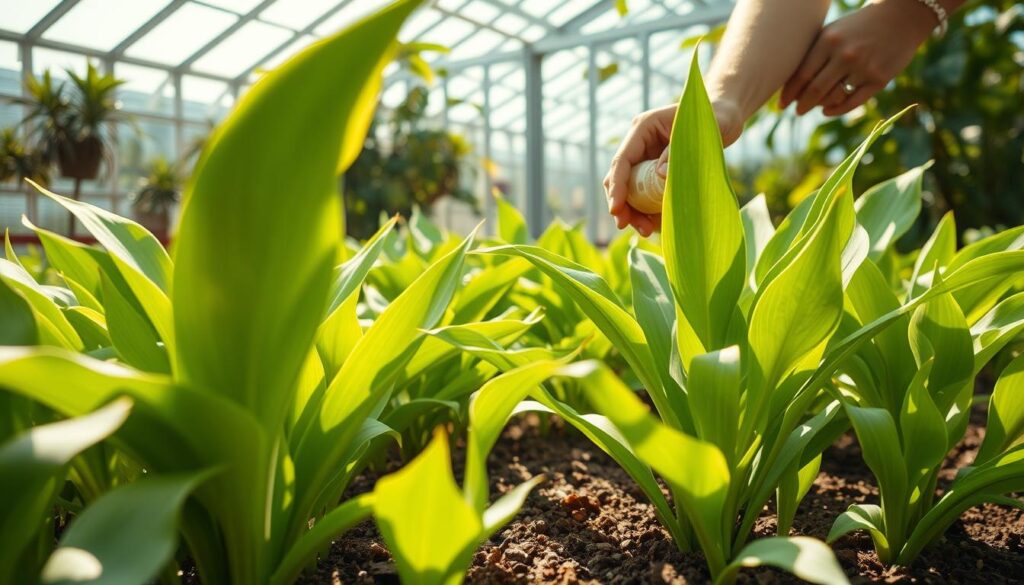
Best Fertilizers for Shingle Plants
- Look for balanced, water-soluble fertilizers
- Avoid overfertilizing, as this can cause damage to the roots
- Dilute the fertilizer to half the recommended strength
When and How to Fertilize
Fertilize your Shingle Plant in the spring and summer. These tips will help your plant get the nutrients it needs. Remember, fertilizing is just part of caring for your Shingle Plant.
Pruning and Maintenance
Pruning is key to keeping your Shingle Plant healthy and looking good. It helps control size and encourages new growth. A good shingle plant pruning guide is essential for the best results.
When you prune, use sharp, clean tools to avoid disease. Cut just above a node for quick healing and less risk of infection. Watch for signs like long stems or too much crowding. Regular pruning keeps your plant in shape and promotes growth.
Proper Pruning Techniques
To prune your Shingle Plant right, follow these steps:
- Check your plant often to spot pruning needs
- Use sharp, clean tools to avoid disease
- Cut just above a node for healthy growth
By following these steps and using a reliableshingle plant pruning guide, your plant will stay healthy and beautiful for years.
Signs Your Plant Needs Pruning
Look out for long stems, too much crowding, and uneven growth. Pruning regularly fixes these problems. Always use a shingle plant pruning guide to prune correctly and support healthy growth.
Repotting Your Shingle Plant
As your shingle plant grows, it will need a new home. This is called repotting. It gives the plant fresh soil and a bigger pot if it needs one.
Check the roots to see if your plant needs repotting. If the roots are out of the pot, it’s time. Also, if the leaves start to turn yellow, it might need fresh soil.
When to Repot
Spring or summer is the best time to repot your shingle plant. It’s when the plant is most active. Don’t repot in fall or winter when it’s sleeping.
Step-by-Step Repotting Guide
To repot your shingle plant, follow these steps:
- Choose a pot that is only slightly larger than the previous one.
- Use a well-draining potting mix to prevent waterlogged soil.
- Gently handle the roots to minimize shock.
By following these steps and repotting at the right time, your plant will thrive. Keep an eye on your plant and adjust its care to keep it happy and healthy.
Pest and Disease Management
When you care for your shingle plant, you might face pests and diseases. Regular checks can spot these problems early. This lets you treat them quickly.
Spider mites, mealybugs, and scale are common pests. Insecticidal soap can help fight these. For diseases like root rot and leaf spot, remove sick leaves. Also, make sure the plant has good air flow.
Here are some tips for managing pests and diseases:
- Regularly check your plant for pests or diseases
- Use insecticidal soap for pest control
- Remove sick leaves to stop disease spread
- Ensure good air flow to avoid moisture buildup
By following these tips, you can avoid common shingle plant problems. This will help your plant stay healthy and strong.
| Pest/Disease | Symptoms | Treatment |
|---|---|---|
| Spider Mites | Yellowing leaves, fine webbing | Insecticidal soap |
| Root Rot | Soft, mushy roots, yellowing leaves | Remove infected roots, improve air circulation |
Propagation Techniques
As you care for your Shingle Plant, you might want to share it with friends or grow more. Propagating Shingle Plants is easy, and cuttings are a common method. You take stem cuttings with two nodes, remove leaves, and plant them in moist, well-draining soil.
For successful propagation, keep the soil moist and warm until roots grow. A warm, humid place helps a lot. Besides cuttings, division and layering are also good ways to propagate Shingle Plants.
Methods of Propagation
- Stem cuttings: Take 4-6 inch stem cuttings with at least two nodes, remove lower leaves, and plant them in a moist, well-draining mix.
- Division: Divide the plant into sections, making sure each section has at least one growing node, and plant them in a well-draining mix.
- Layering: Bend a long stem down to the soil, secure it with a rock or a U-shaped wire, and wait for roots to develop.
By using these methods, you can grow more Shingle Plants. Make sure they have the right conditions, like warmth and humidity, for the best results.
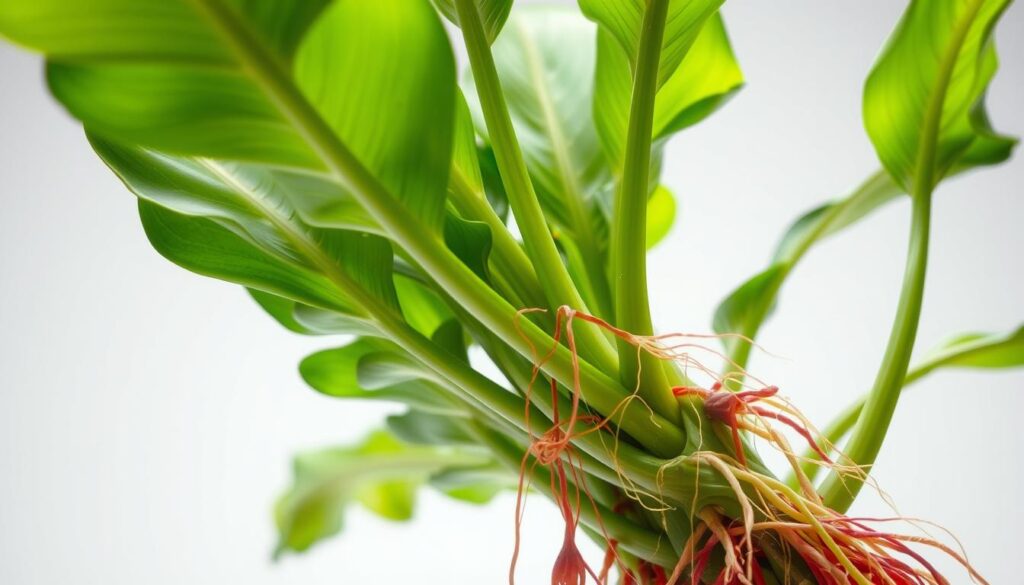
Environmental Considerations
Caring for your Shingle Plant means thinking about its environment. This includes the space it’s in and how it affects your plant. You should consider if it’s indoors or outdoors and how that impacts its care.
Shingle Plants do best indoors with steady temperatures. They like consistent temperatures and humidity. If you put it outside, choose a shaded spot to protect it from harsh weather.
Here are some key things to think about when placing your Shingle Plant:
- Temperature: Keep it in a spot with a steady temperature between 65-75°F (18-24°C).
- Humidity: Aim for a humidity level of 50-60% to keep your plant healthy.
- Lighting: Give it bright, indirect light but avoid direct sunlight.
By considering these factors, you can create a great environment for your Shingle Plant. Adjust your care routine with the seasons. Water less in winter when it’s dormant.
With the right care and environment, your Shingle Plant will thrive. It will add beauty and life to your space.
| Season | Temperature | Humidity | Lighting |
|---|---|---|---|
| Spring | 65-75°F (18-24°C) | 50-60% | Bright, indirect |
| Summer | 70-80°F (21-27°C) | 60-70% | Bright, indirect |
| Autumn | 65-75°F (18-24°C) | 50-60% | Bright, indirect |
| Winter | 60-70°F (15-21°C) | 40-50% | Low, indirect |
Troubleshooting Common Issues
When you care for your Shingle Plant, you might face some common problems. Yellowing leaves and leaf drop are two big issues. It’s key to know why they happen and how to fix them.
Yellow leaves can mean you’re watering too much, not giving enough nutrients, or exposing it to too much sun. Try watering less, feeding it nutrients, or moving it to a sunnier spot. Leaf drop might be due to not watering enough, extreme weather, or drafts. Adjusting your care can help avoid these problems.
Here are some ways to solve these issues:
- Adjust your watering to keep the soil just right
- Fertilize regularly to give your plant what it needs
- Move your plant to a spot with filtered sunlight
- Keep the temperature and humidity steady to avoid stress
Knowing these common problems and how to prevent them can help your Shingle Plant flourish. Keep an eye on your plant and adjust its care as needed. This way, it will stay healthy and look great.
Final Thoughts on Shingle Plant Care
Caring for your Shingle Plant (Rhaphidophora hayi) needs regular attention and understanding of its needs. This includes the right amount of Shingle Plant care and handling any issues that come up. Each step is crucial for your plant to flourish.
Recap of Key Care Tips
Water your Shingle Plant about 0.5 cups every 9 days. Place it less than 3 feet from a bright window for sunlight. Repot it when it doubles in size. Watch for pests or disease and fix any problems, like yellow leaves.
By following these tips, you’ll enjoy the beauty and benefits of this amazing plant.
Encouragement for Plant Enthusiasts
We urge all plant lovers to keep exploring Shingle Plants. Share your experiences, insights, and tips with others. The more we learn together, the better we care for these plants. Happy planting!
To Check out Michelle on our YouTube Channel where she shares all things Plants see her HERE!


